
 |
ROLEXROLEXROLEXROLEXROLEXROLEX
 ROLEXROLEXROLEXROLEXROLEXROLEX
ROLEXROLEXROLEXROLEXROLEXROLEX
|
|||||||
 |
|
|
Thread Tools | Display Modes |
|
|
#1 |
|
"TRF" Member
Join Date: Mar 2009
Location: worldwide ;)
Posts: 390
|
Vintage Rolex Buyer's Guidance to determine the originality of your watch..
My Vintage Rolex Buyer's Guide
 To complete my earlier RPR post: A brief introduction into the world of vintage Rolex and Patek Philippe collecting I like to add my quick guidance today to determine original vintage Rolex – or any kind of vintage watch brand in general. I noticed yet again that even seasoned collectors still ask me on a regular basis the obvious advise about originality. The main question I always ask myself, is what has been done to the watch during it’s life, wear wise, service wise and dealer wise. In a constantly developing market, where fine and honest quality has gone mad price-wise during the auctions, I wanted to add a basic guidance to determine the originality of a vintage Rolex to help understand any watch collector who is serious about his hobby. After I’ve spend like 25 years looking at a watch face, case and movement, analyzing what has happened to it ( changed with original parts, restored, serviced with later parts ) during its life, comparing & discussing them on specialized watch forums, I think it’s now become time to share some of my experience. I will further develop and update this post in the near future but felt today like starting to share the most necessary information already with you. I want to discuss the following steps:
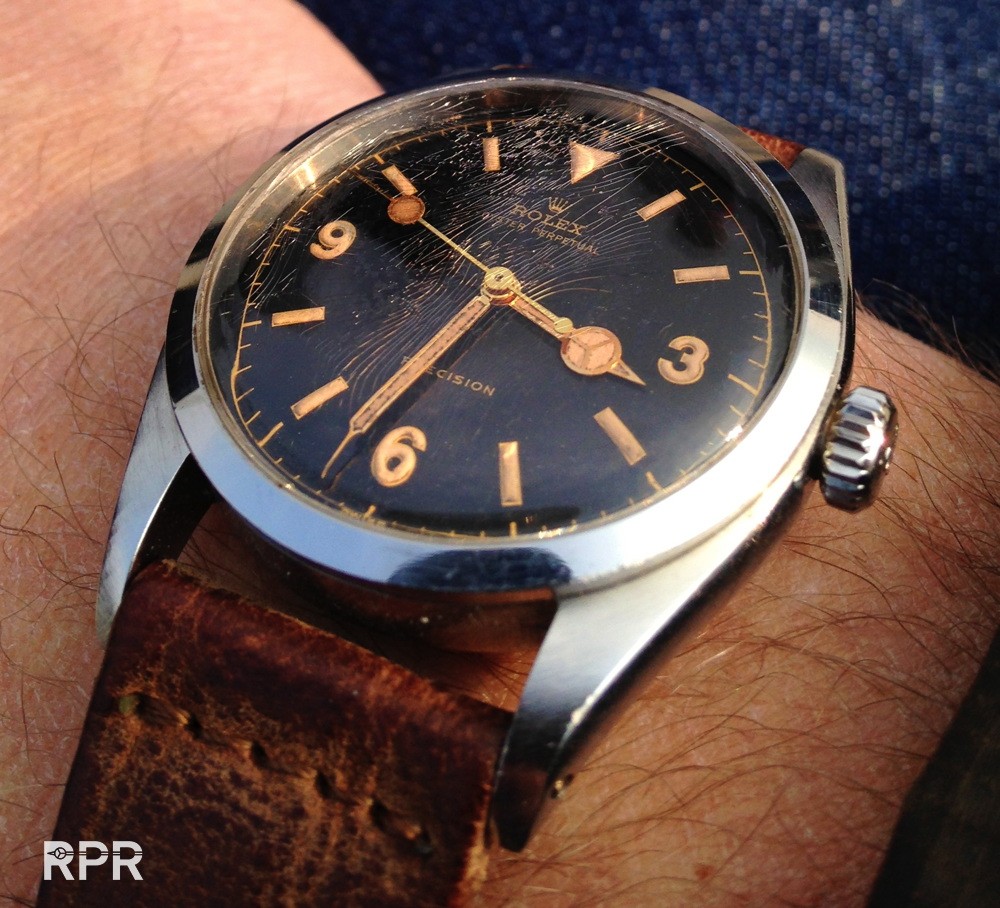 In the modern vintage watch world, which is full of “put together“‚”swapped“‚”cosmetically enhanced” and “photoshopped” online and offline offers, at first we have to determine the meaning of the words: “all original“. The current market ( as we see at the recent Geneva watch auctions yet again) has become all about rarity in the reference and condition but generally the word “original” is being abused by most offers you found out there. So what does “all original” mean in the watchword? My explanation to this is: A Rolex (or any kind of watch ) that still is in exact configuration as it was back then leaving the factory when it got delivered to the shop and bought by the client. As watch brands have delivered their watches over the world in sometimes different configurations, due to import tax, local taste or for instance special orders, the ultimate version to have, is the one being shown in their catalogue at the yearly watch shows ( think of Basel World ) As many global watch brands used to do and in particular the penny-pinching swiss ones, factories always use their left over stock of spare parts in their next designs. Then as most iconic watches where not very popular when they came to the market, it took sometimes 5-10 years or more to sell the initial batch the manufacture made of them. What we often see is that later delivered examples have different dials, bezels and or updated movements making them not exactly the same in detail as when the first ones got introduced. 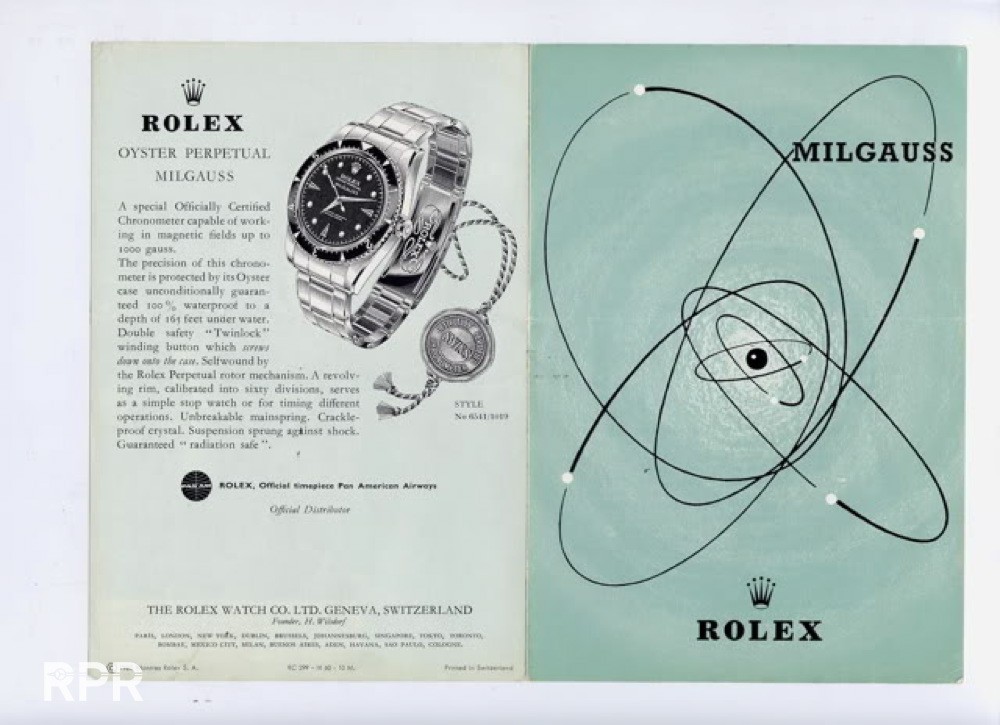 A mayor influence on the originality has been played by the manufacture itself, namely during the servicing the watch. Original old parts, most importantly the dial and the hands, have often been changed due to the fact the new radiation regulations that became obligatory after 1964. The chance from radium to tritium ( with a maximal radiation of the total watch of 0.25Mvsr ) changed the dial description at 6 o’clock from ’Swiss’ to T-Swiss-T and later T-Swiss<25. Its due to all these facts that I use the word “Catalogue style” to determine the best possible version / configuration one should collect. A Rolex that’s still like it was published in their old catalogue, being from the first batch, not been serviced with later parts is the ultimate one to have imho. 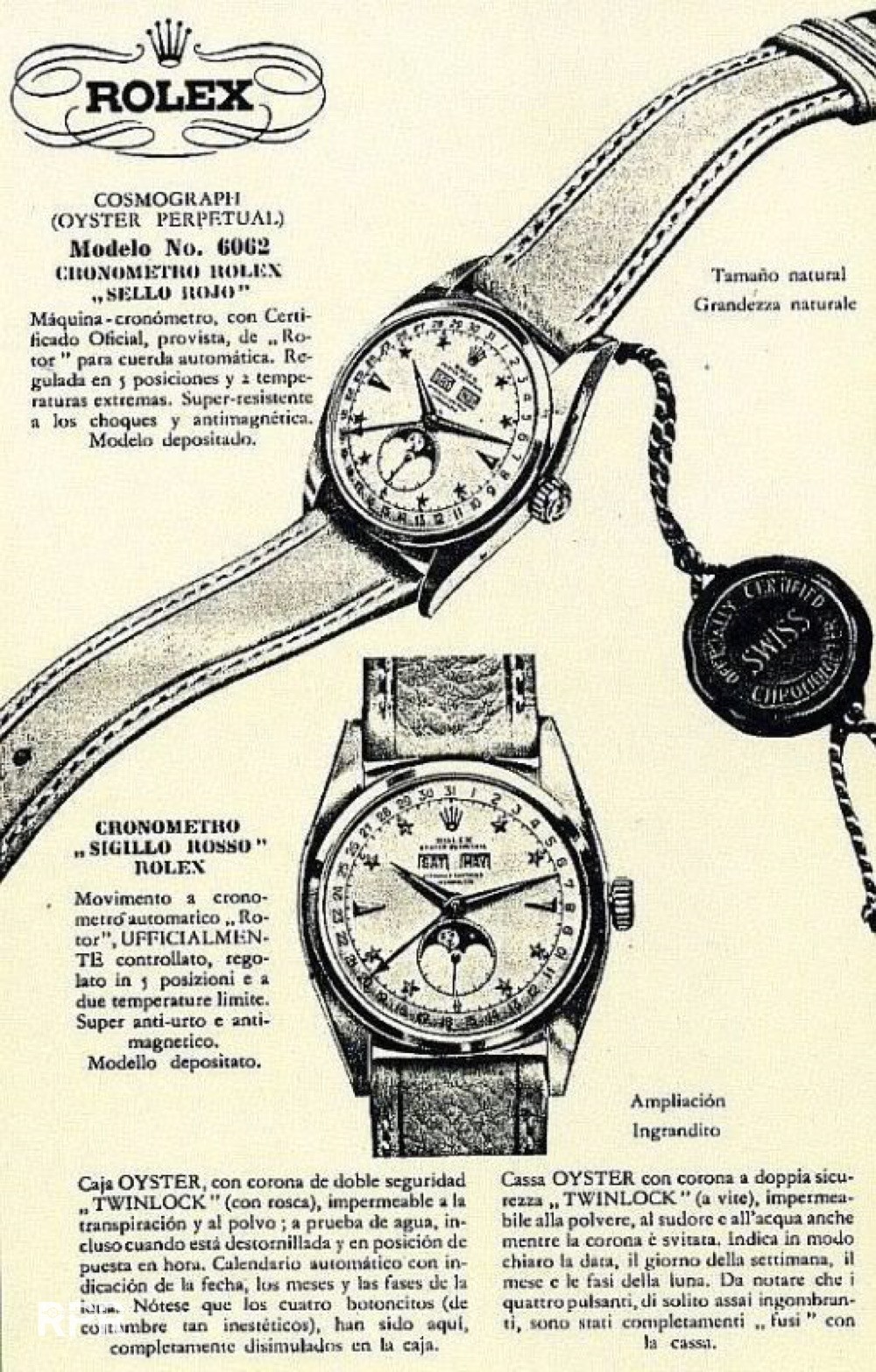 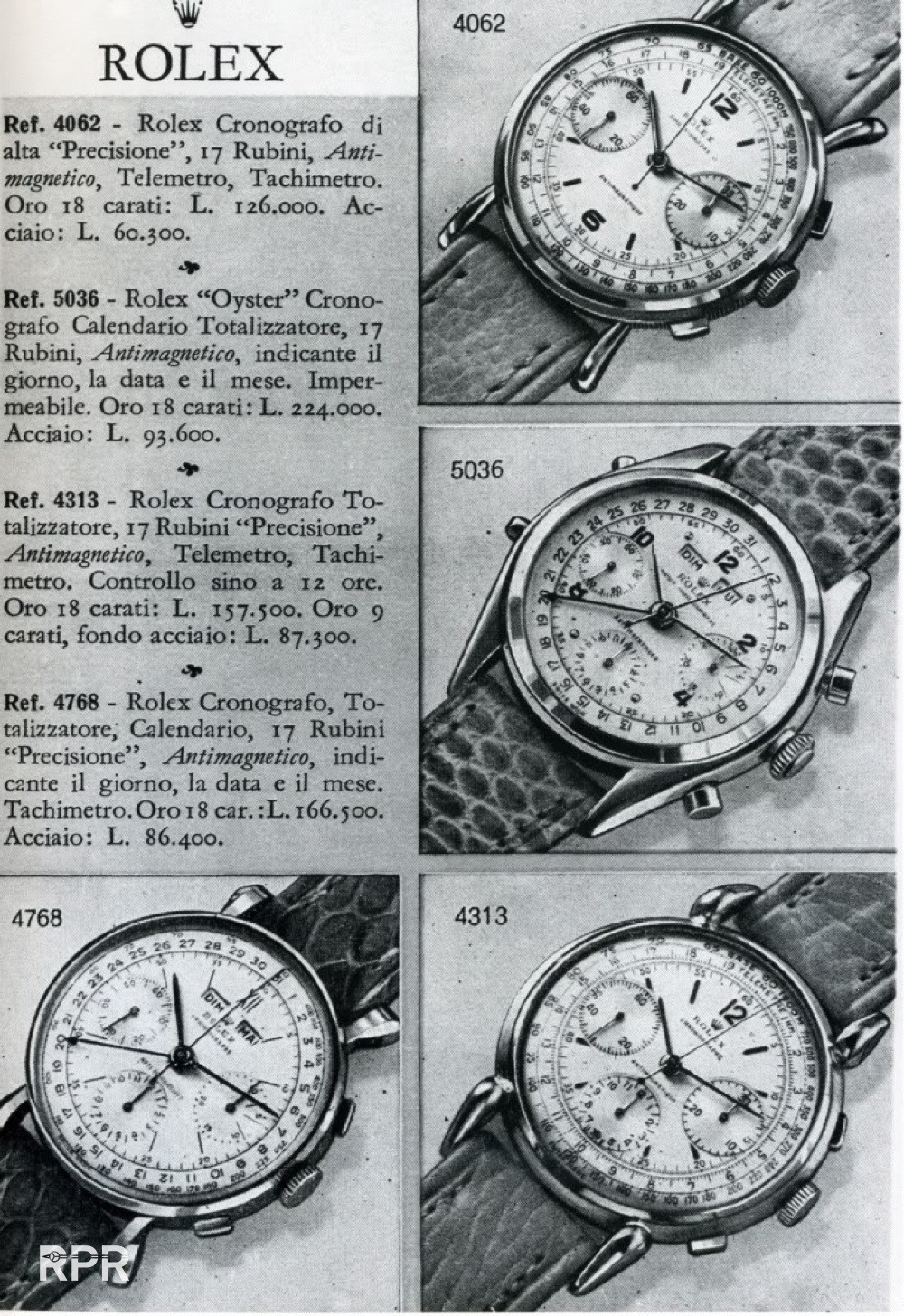 Advise: Use Google to find pictures of original old catalogues. Specialist watch forums can help you out as well. As some forums are closed and google can’t get the picture out there to show you, it’s most of the time a small effort to register yourself and then use the ’search option’ For Rolex I can highly recommend VRF (www.VintageRolexForum.com) Besides the many freshly found examples that have been posted over the years, there’s a „Vintage Dial Archive”, „Rolex Serial Number Project” and a „VRF Classic Post” sections that are very useful to go through. 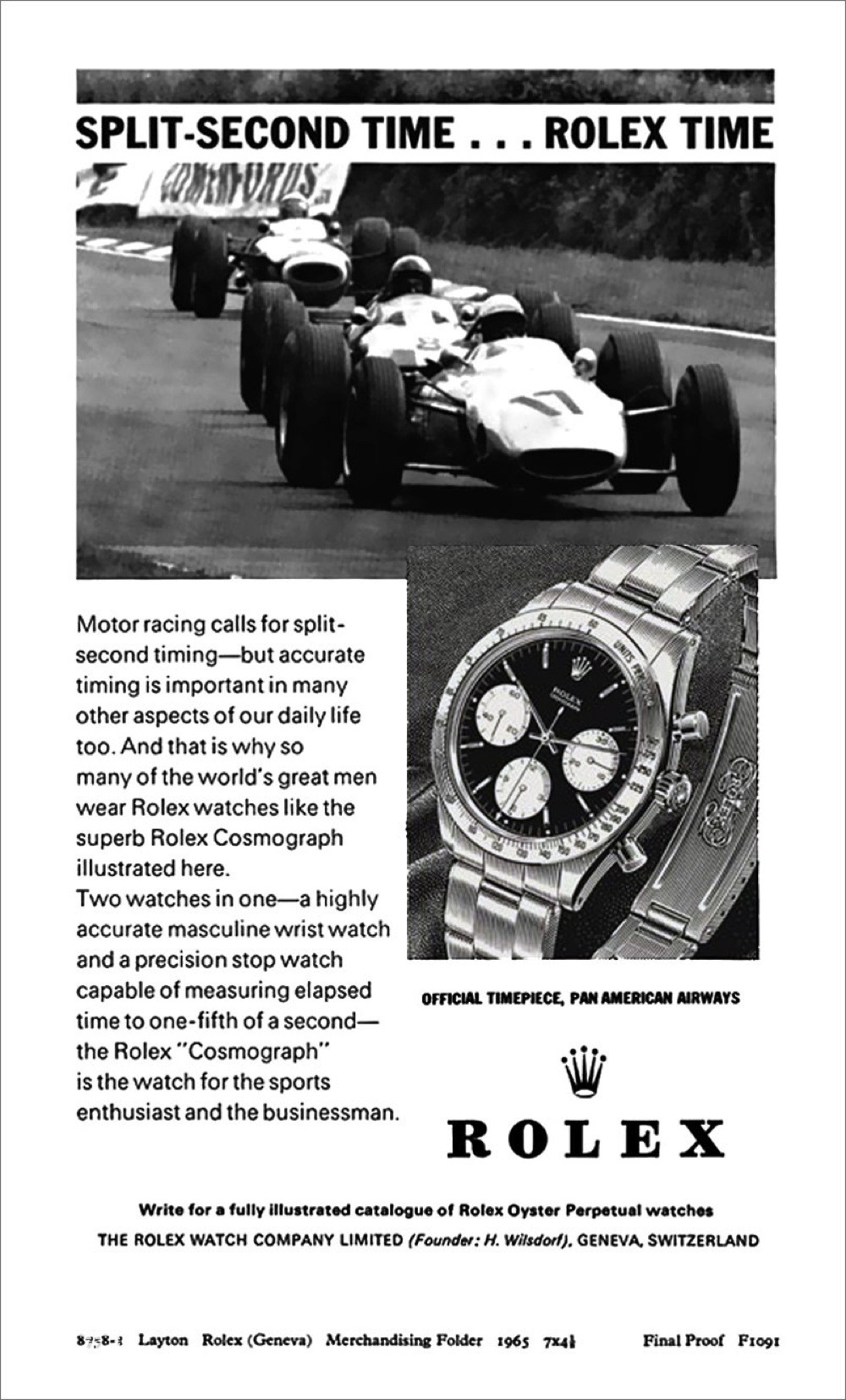 Analyzing the fonds of the Rolex serial numbers engraved between the lugs up close… 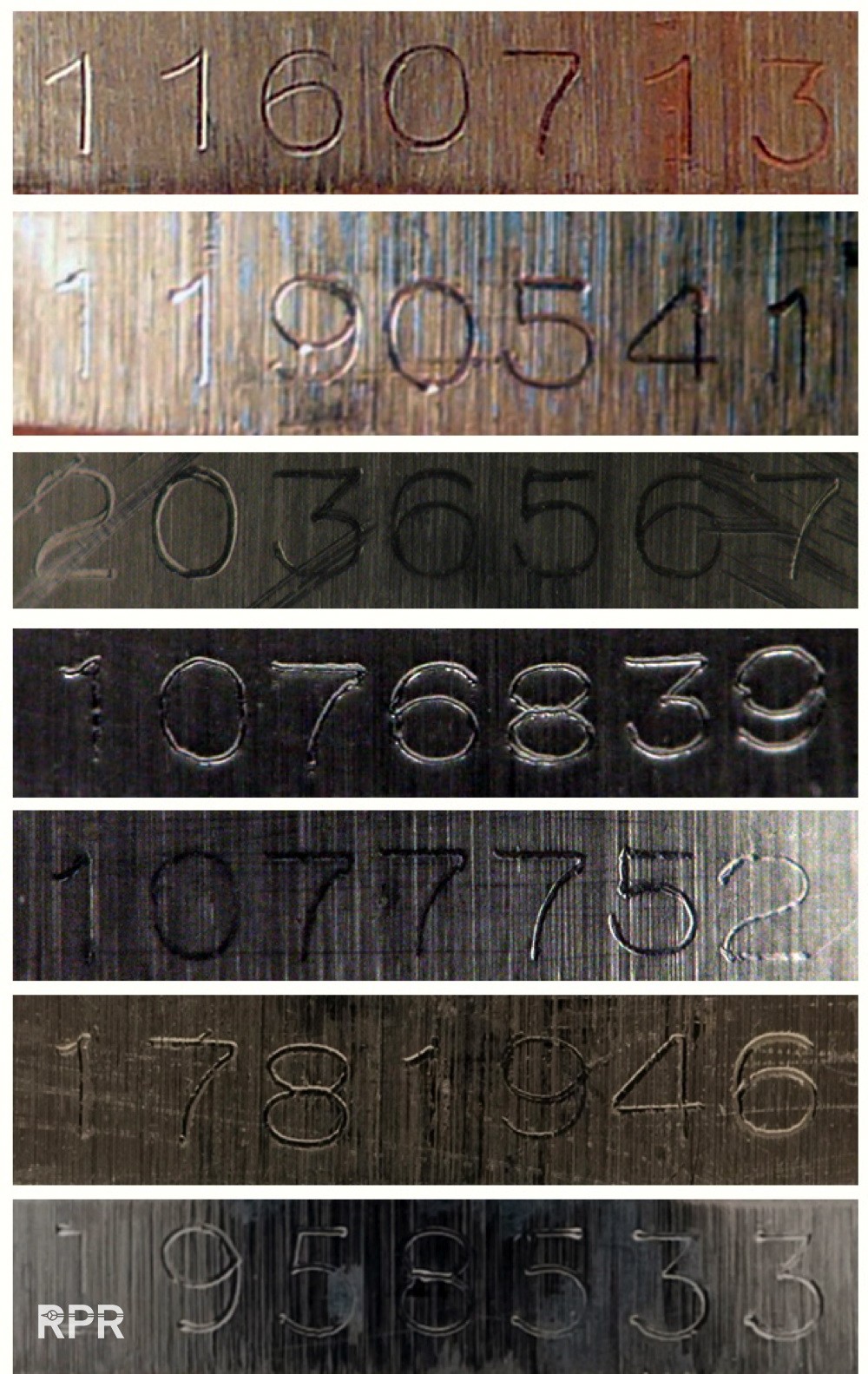 Up close, the reference number, below the Brevet + marking. 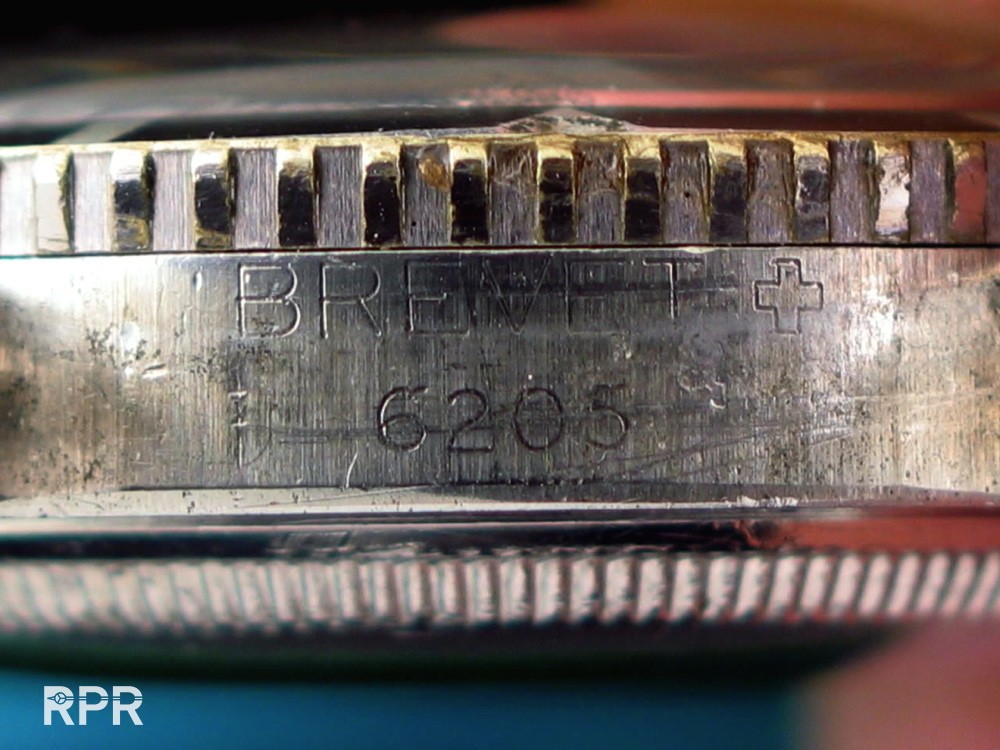 Here we see a 1963 by serial number mentioned on the Chronometer Certificate Explorer Ref 1016 with so called “Underline”, sold in The Netherlands in 1965. Although it’s having the “minute track ” & it’s marked only with “Swiss” at 6 o’clock, the luminous is not radium but already later Tritium, the geiger is below 0.25Msvr as you see below… 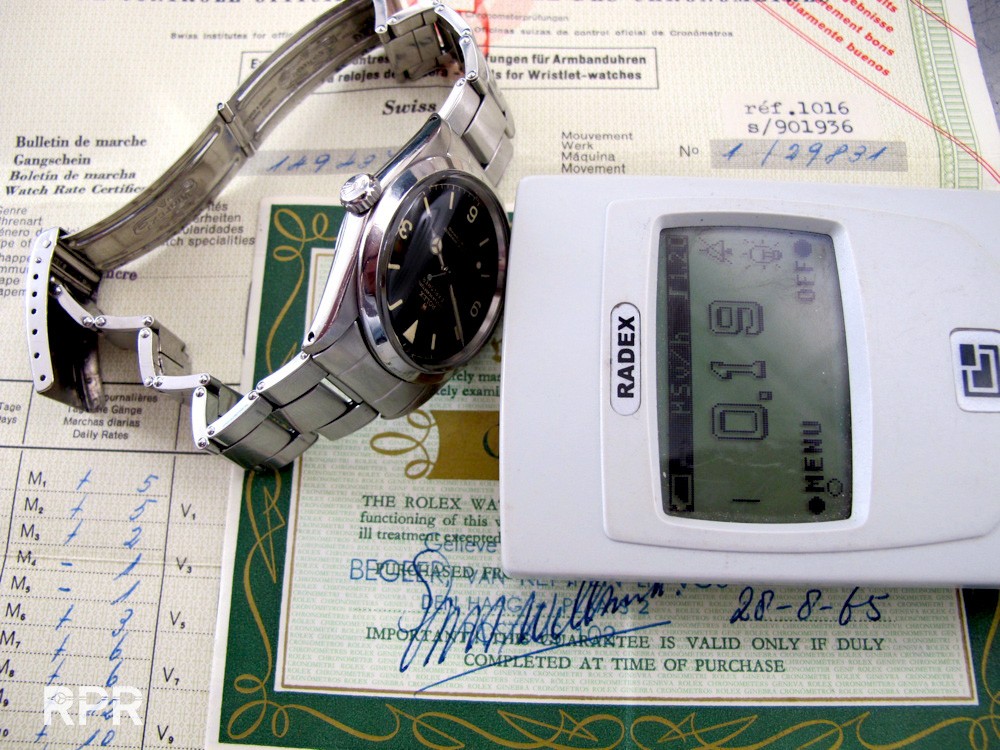 Now we know what is the best to collect, next step is to determine the quality. What we often see when we analyze any watches on their condition, is that often the „ all over patina” is not matching. An old watch that have been worn and stored during time it wasn’t on the wrist of the owner, will get a tone in the face ( obviously I mean the dial ) further it has little dents on the common edges of the case, show wear on the crown and leave marks between the lugs from the bracelet that was attached between the lugs. For instance a damaged & worn-down case with a perfect dial and hands. Or the other way around, a perfect case with a non perfect dial are signs that someone is trying to cover up earlier damages. Advise: check out ‚honest, untouched’ offers from private clients of any kind of old watches on Ebay.com to get a feeling how a watches ages over the years. I can also advise you to check the sold archive of Bonhams auctioneer that they have online as this auction house hardly take any ‚dealer prepared’ offered lots into their sales but just auction them as it is. Ones you have looked through many examples, your eyes get trained to spot original patina. Below a NOS Submariner.. 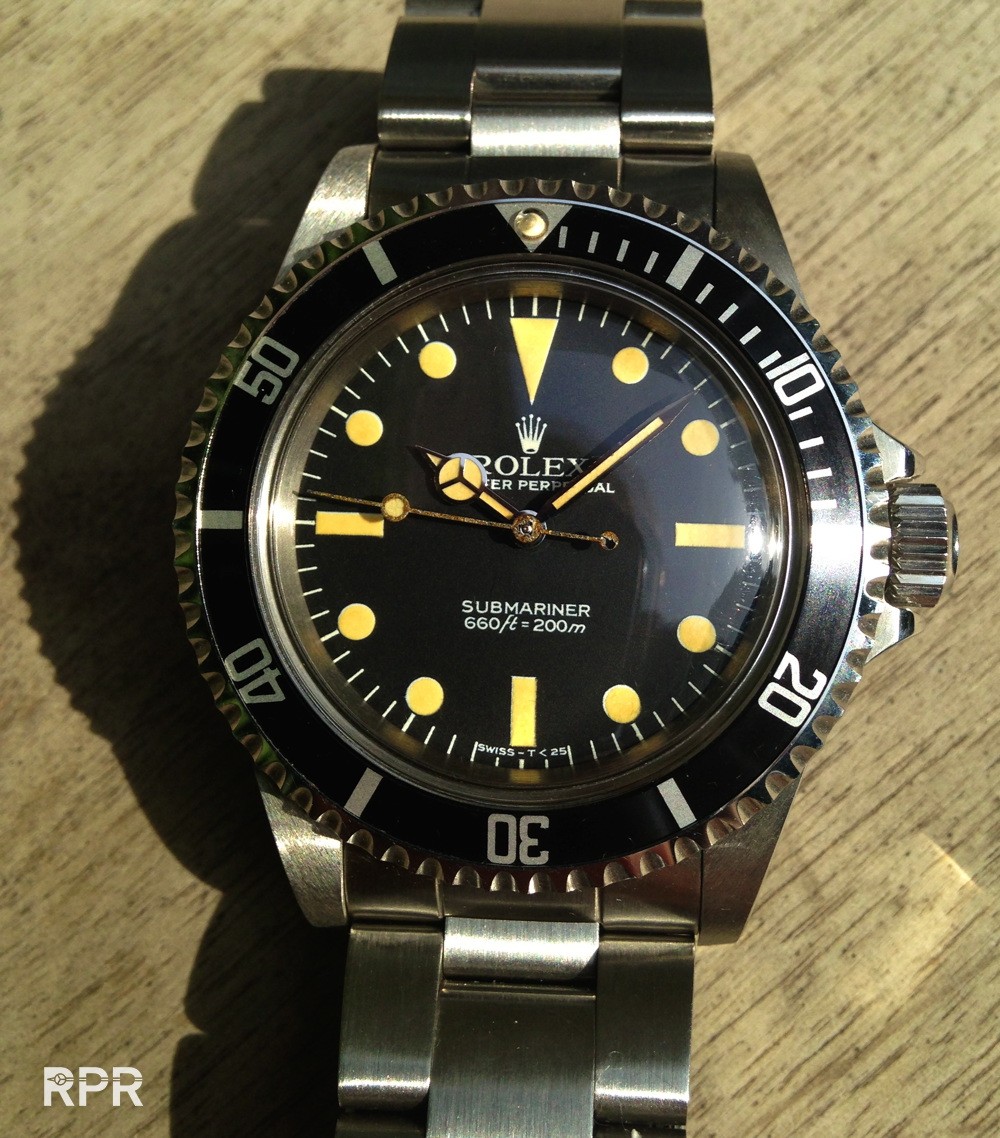 Next you see is a first owner find Rolex Paul Newman where all luminous dots are still in tact and the luminous of the hands are matching the dial. It’s an earlier version, notice the much smaller sized second hand in the 9 o’clock register and different lay out of the bezel engraving, this is one of the first ref 6239′s. Secondly you also see black 3 color Paul Newman where one could easily say it’s the same as above but it’s not, is a later transitional ref 6262.. 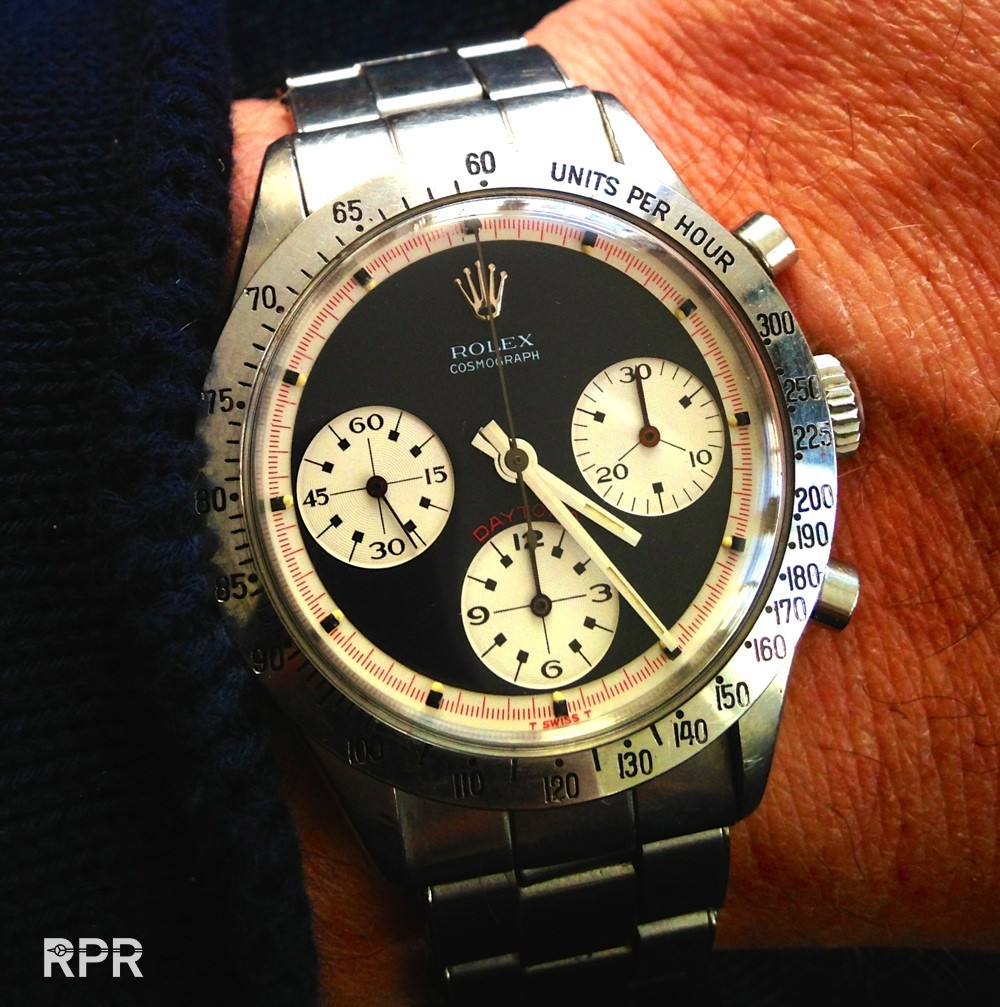 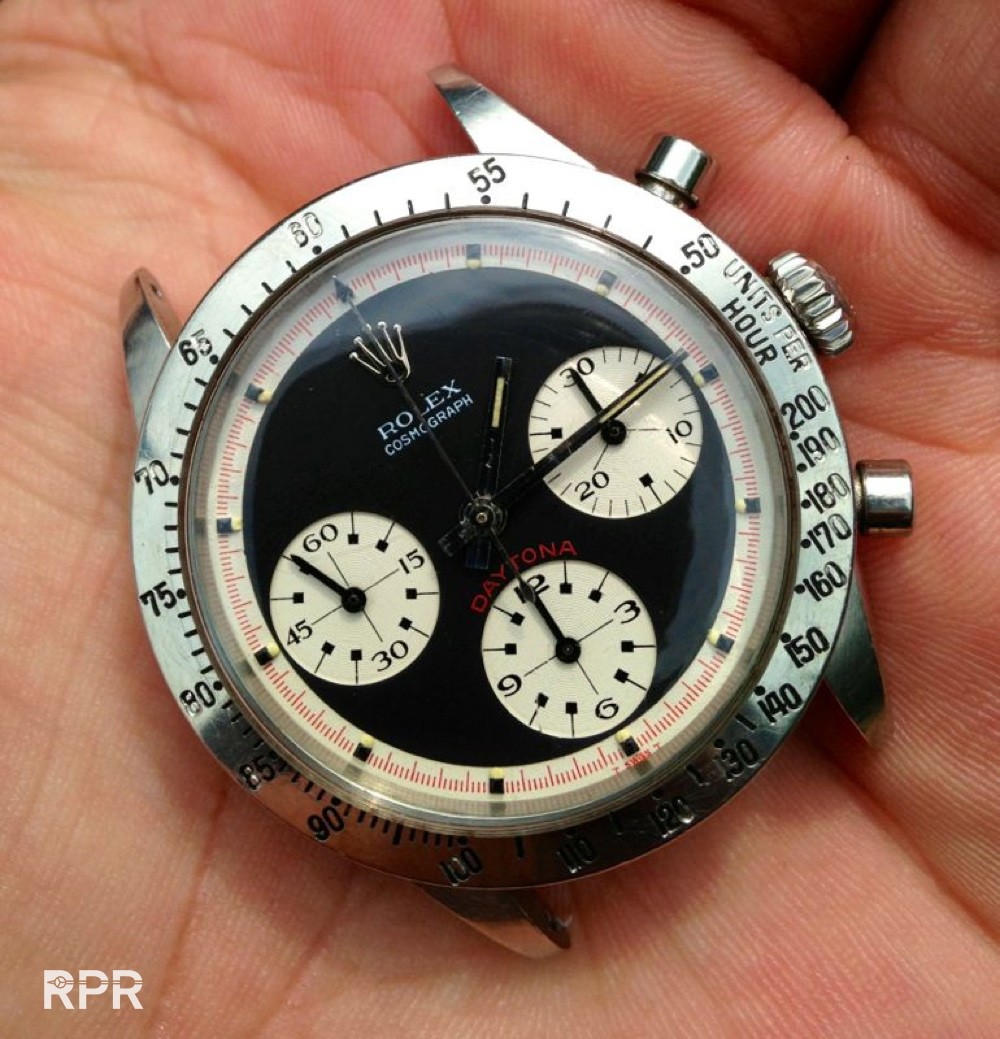 And without the crystal… 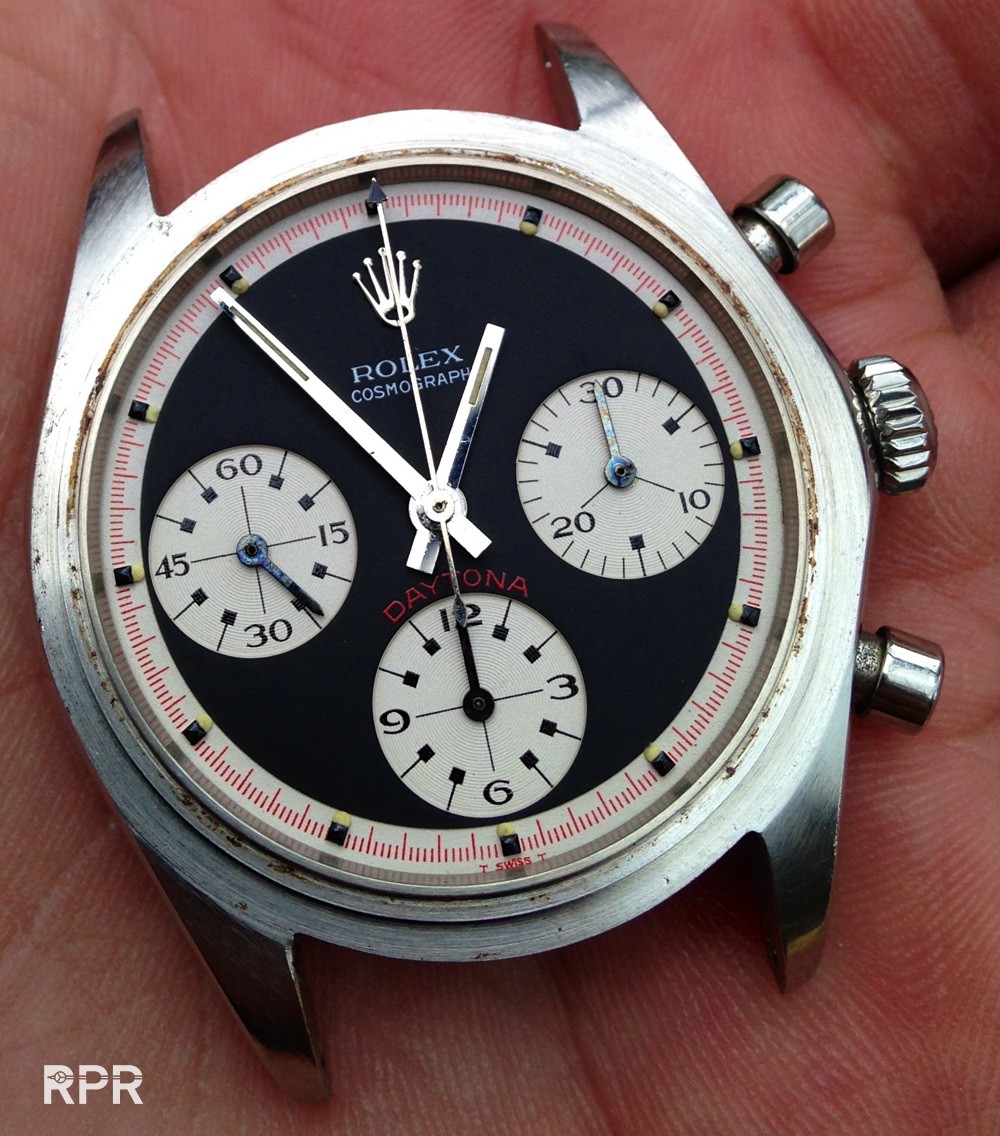 Maybe the best tip I can give you for the popular Rolex or any kind of luminous dialed watch, is always to check the luminous up close! The biggest problem one can have with a watch is humidity, entering through a broken crystal or damaged crown. The water condensation ( which is in many cases salt or chloor water) destroys the movement and will also slowly damage the dial and hands. Therefor I call the luminous material on hands and dial ( which is generally fluffy and added perfectly round on the dial) the highly important „moisture meter”, showing us what has happened inside the watch during its life. Once moisture has entered the watch, the luminous sucks it up and will become very dark on the top and sometimes even fall off over time. The luminous in the hands tend to tone greenish, leaving marks of corrosion on the surface of the hands. See below how original tritium glows up under ultra violet light.. 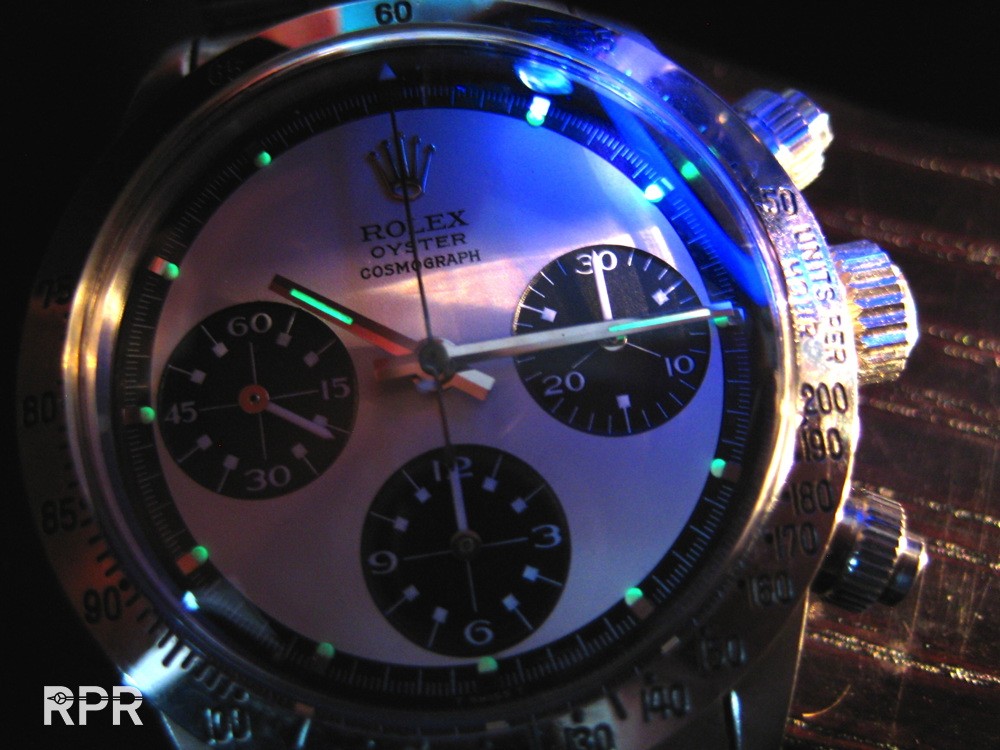 What we are looking for is „matching luminous of dial and hands”, both have to be in the same color, still fluffy and undamaged. In general you can say that the correct tone on earlier radium (Pre 1964 examples) is a „cappuccino” color and later tritium (after 1964) is a bit lighter, more yellow cream. As many dials during their lives have been re-lumed (newly added luminous due to water damages or because customers wanted to see it light up in the dark again as tritium has a lifespan of 12.5 years and looses its brightness ) we often see the all over patina is not matching. The luminous now looks newer then the rest of patina on the watch, isn’t matching the color of the hands nor does it has the same radiation as original ones. One should always focus on the luminous as this tells you what really happened with the watch you’re examining! See yourself with below luminous dots on the dial, they look non matching, are more yellow greenish, there where the tone of the hands are cream… 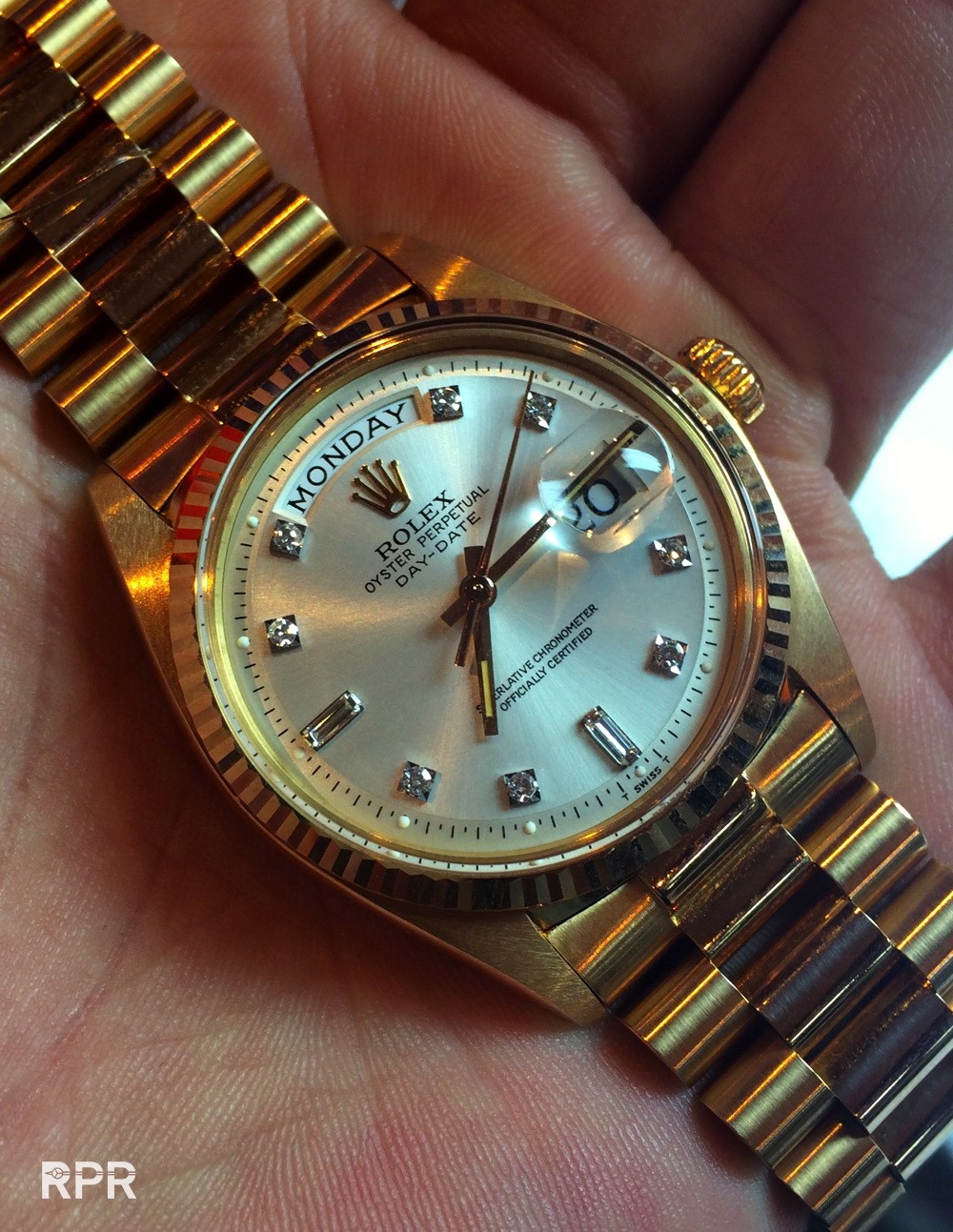 Below we see a all over matching patina on the dial and hands, after the crustal has been removed we see some dirt, that’s also located around the crown & pushers.. 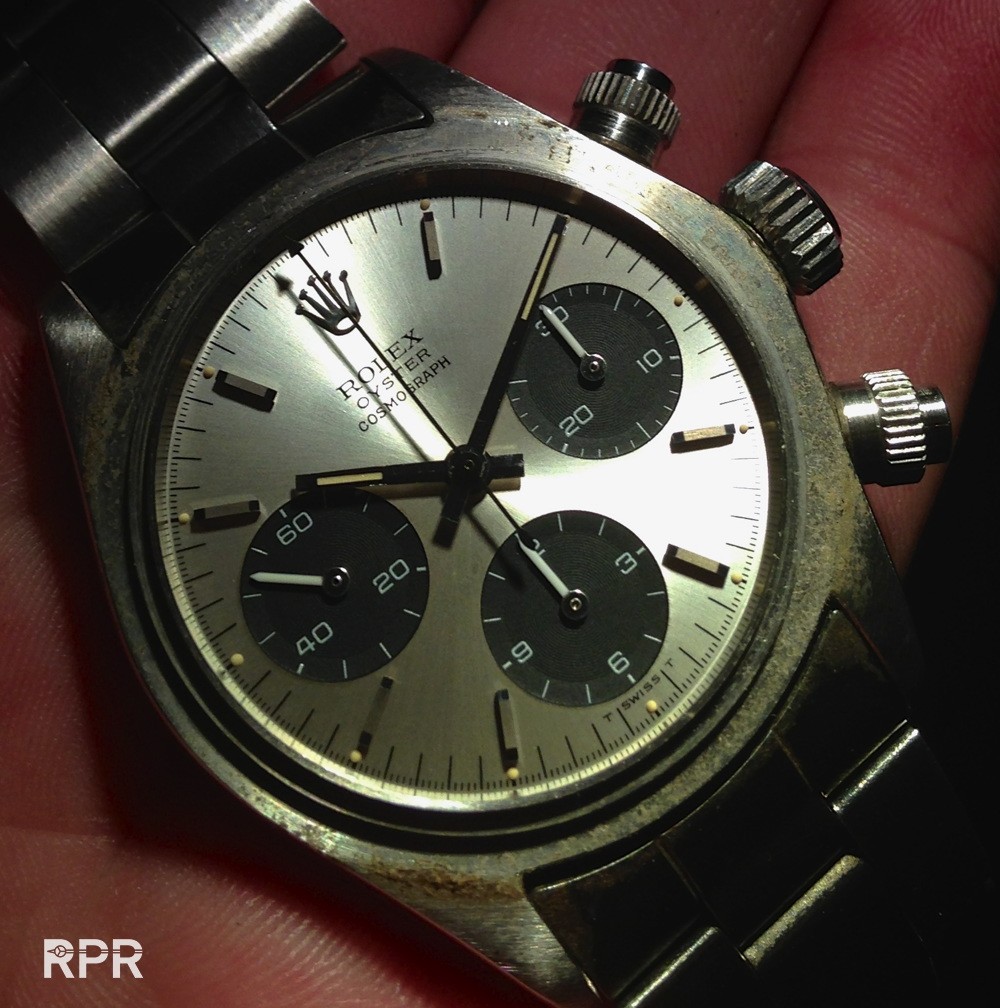 Matching luminous all over, no marks on the dial, no marks on the hands near the center where a watchmaker takes them off and unpolished case and bracelet.. 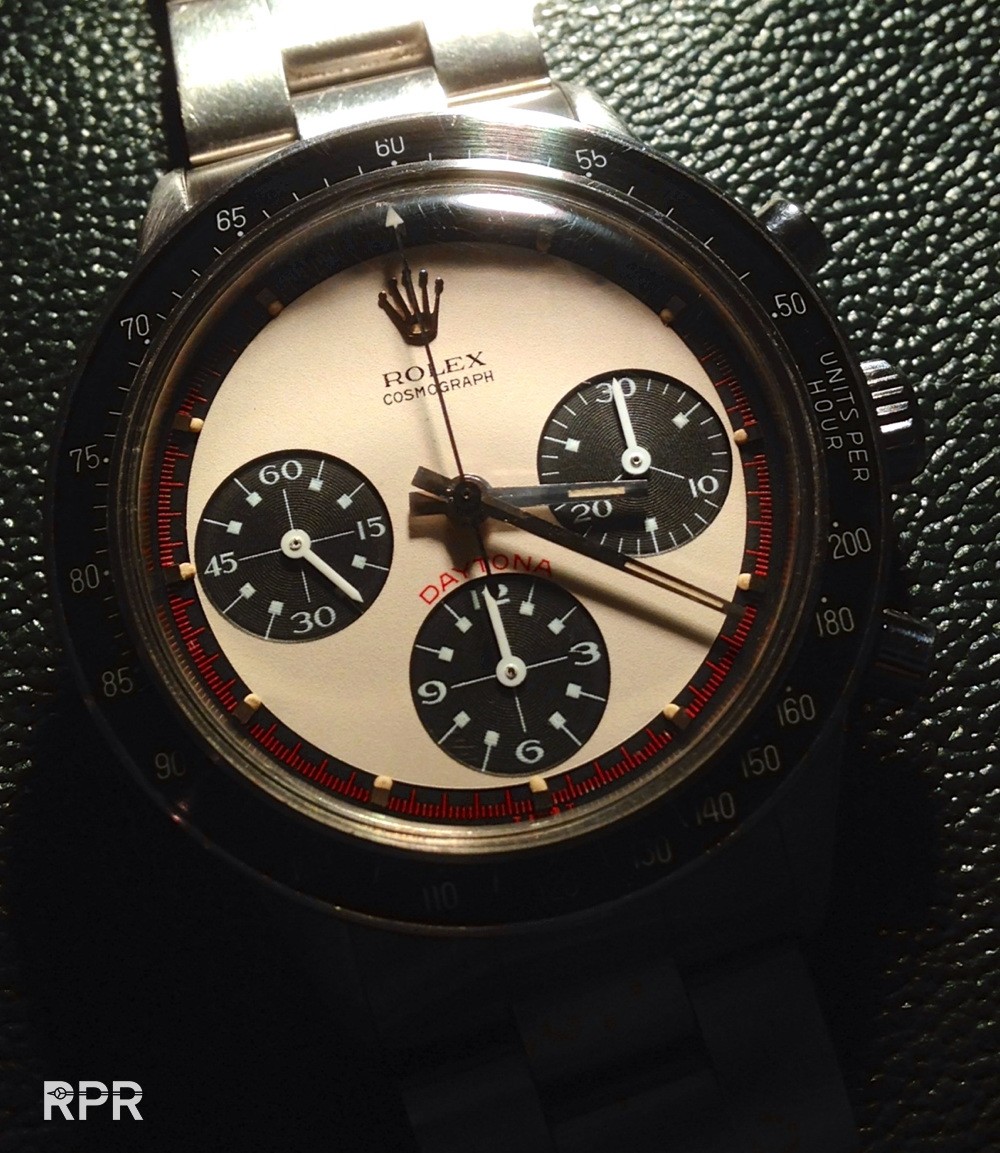 Swapped, period correct parts has become a art in the vintage watch world. It’s due to the extensive experience and knowledge of the collector or the dealer to upgrade a already nice and original watch into the most wanted “Catalogue Style”. For instance if a crisp Big Crown Submariner from second batch (1957-1959) has been found but for some kind of a reason (Rolex didn’t always deliver their watches as seen in the catalogue) it’s missing the iconic red triangle bezel, finding the correct red triangle thats matching with the all over patina of the watch is very difficult! By doing so, you change history and to me one should always save the old original part where the watch was found with and mention the upgrade when it’s been sold. Genuine vintage parts have therefor become blue chips. An original, un cracked bakelite bezel for a early 6542 GMT Master is like 1/2 the price of the watch. An early Milgauss & Military bezel or hands or even later all red 24 hour hand, all blue GMT bezels have exploded in price due to the fact the most watches where damaged, got changed during a service or simply where not delivered back then with it as nobody really cared about these details from the way we collect nowadays. We have to realize that most of the rare watches from today where made in small batches and where not very popular in sales. It took sometimes years to sell a initial batch and therefor we see first owner watches, never been serviced but still having later parts on it. To bring it back in catalogue style has become an art by itself. I prefer the real deal, below a first owner 18 carat Paul Newman Daytona still in untouched with plenty of DNA left, all original condition.. 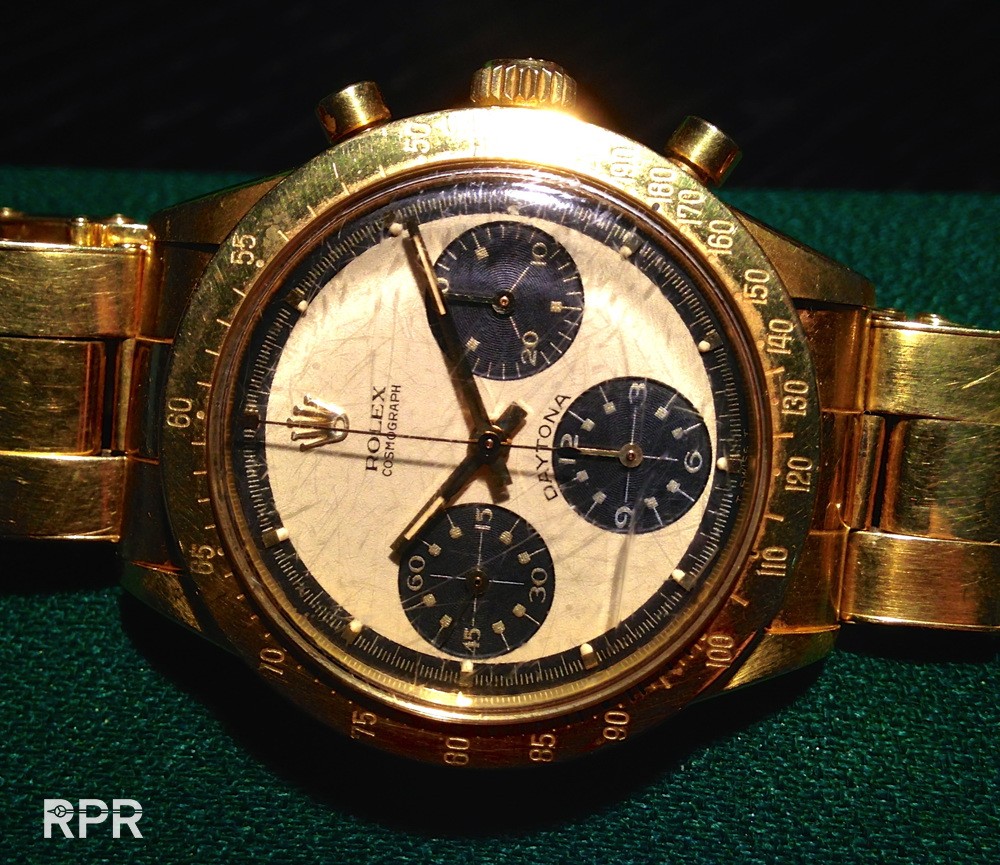 A hot topic are the so called „Tropical Dials”, dials that changed color from black to brown. I highly recommend to double check the luminous on these dials as we hardly see any truth tropicals around any more. The problem that moisture in most cases has, can become a dealer advantage as the top layer has been damaged and then chances the structure of the dial radically from black to brown. To get this damaged dial yet again attractive and all matching, dealers will re-lume it to hide the water damage. There are even watches around that have hand colored sub dials or have been put into a magnetron to speed up the process. A true tropical dial has perfectly matching original luminous, an untouched top layer of the dial and chanced color because it used to be worn in a very sunny area and then got stored for many years in a dark place ( safe ). Up close this original tropical dial will look the same as a perfect non tropical brown, the surface is still intact, luminous is original and when you loupe it 100X you see the original one has a brown and a blackish pixel next to each other, there where artificial ones will show you only brown pixels. There’s thus a big difference between an original tropical or damaged dial, only original ones deserve a premium!  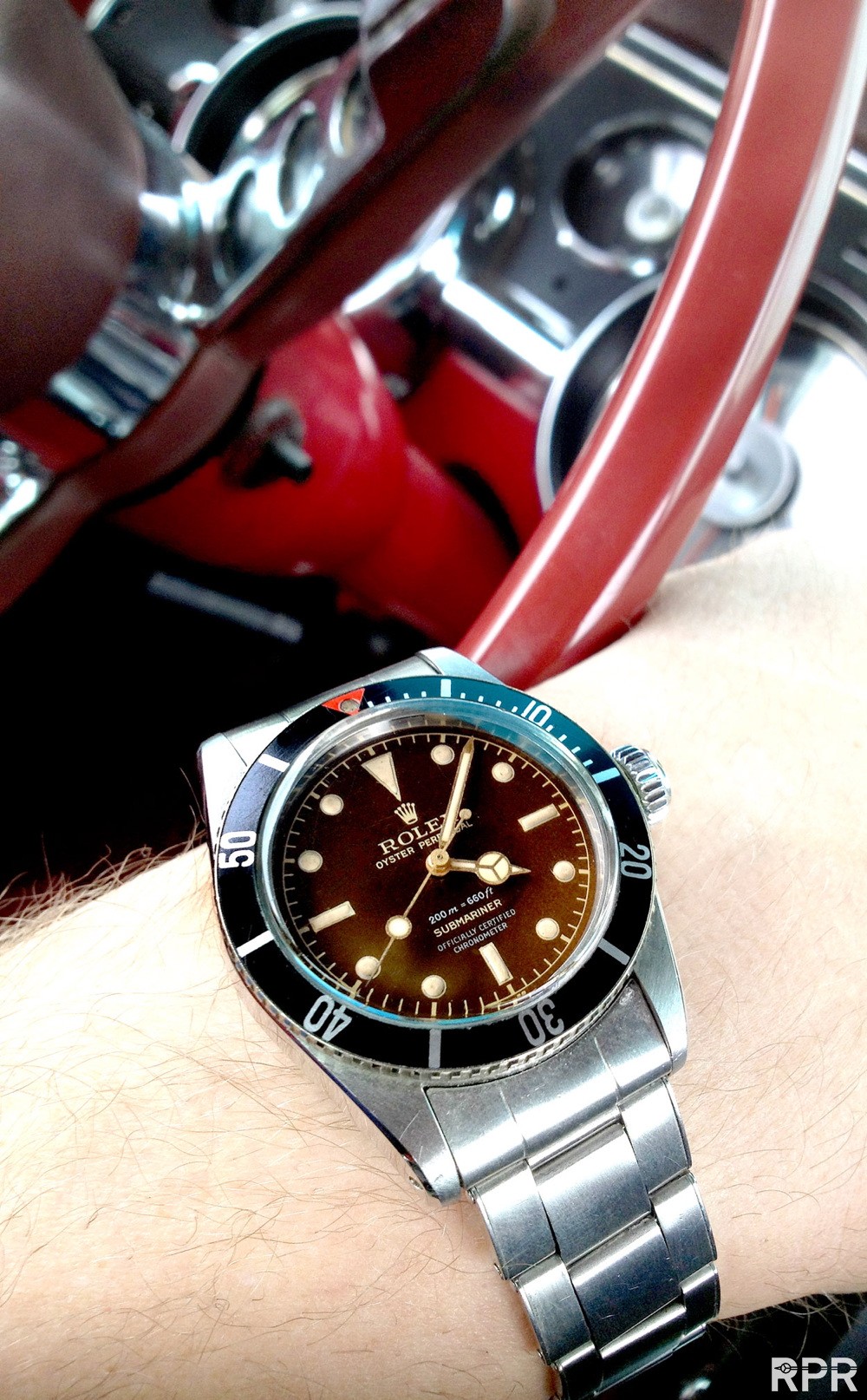 Advise: Buy yourself a regular Geiger meter (€ 150-200,=) to determine the radiation of your watch. Early 1950 watches with radium lume have a radiation of at least 20-100 Mvrs. The more we go to 1964, the less aggressive the luminous becomes, ending in 1964 when international law forbid to have more then 0.25Mvsr on radiation on a watch. I’ve written an interesting article about „transitional luminous” Rolex using Geiger meters to unravel the mystery of „The Underline”. After we now know where to look at, by analyzing the luminous, if a Rolex is still in all original condition, we focus on the case itself. My experiences tells me that even a heavily worn watch still has its original shape. Maybe the edges are a bit worn off but generally i’m always surprised who great the shape of the case still is with a fresh find once it has been worn for like 50 years. As we hardly see these „untouched” cases any more, its logic to state that most watches have been „polished”. If you’re not yet aware about how a certain reference should look like once it’s not polished, I recommend you to take a loupe and look closely to the matt polished part of the watch. It’s with the matte parts where you can determine if a watch is polished or not. 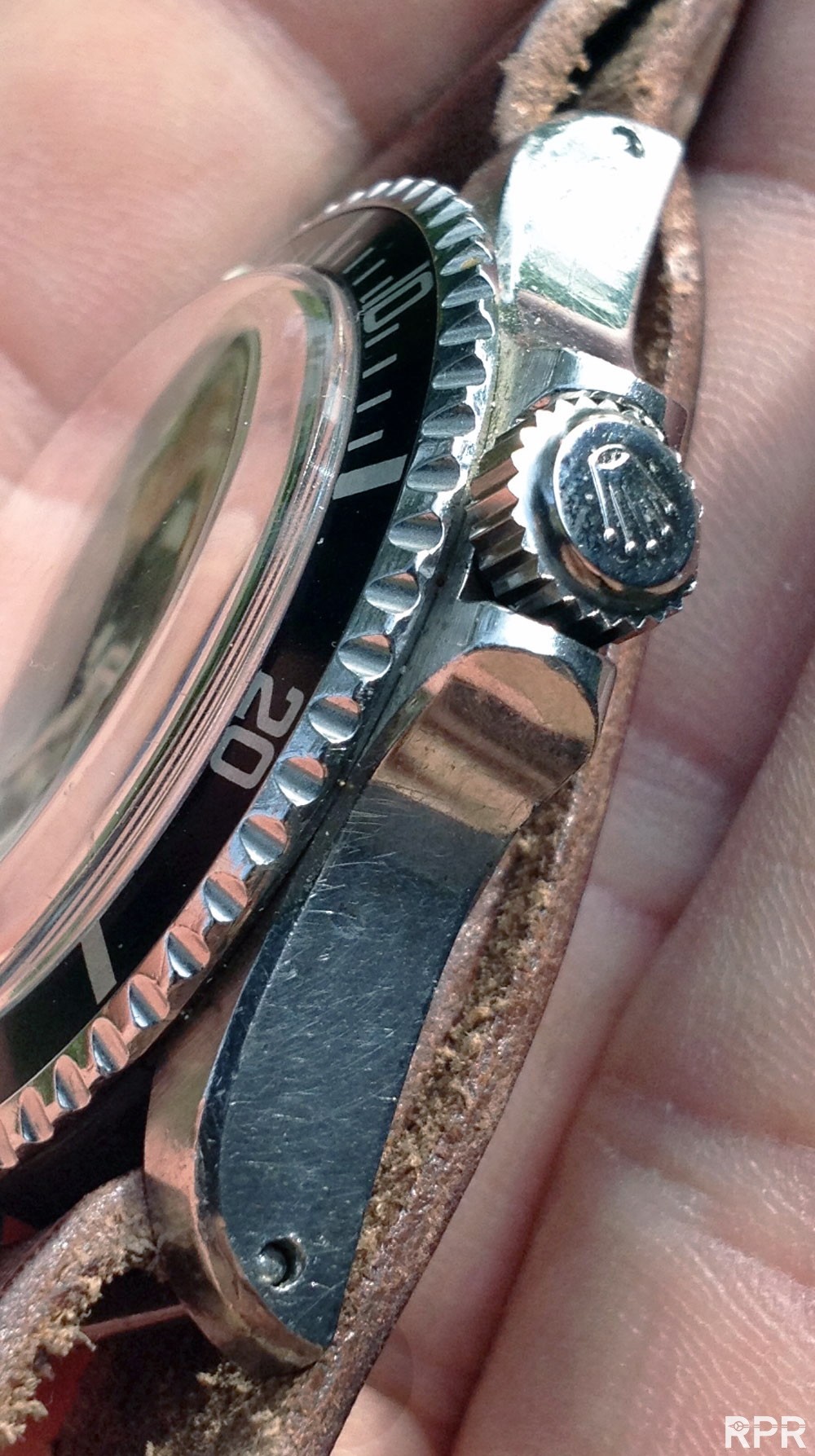 Up and down, we see 2 x unpolished chamfers, beveled edges that are so particularity loved by vintage Rolex collectors.. 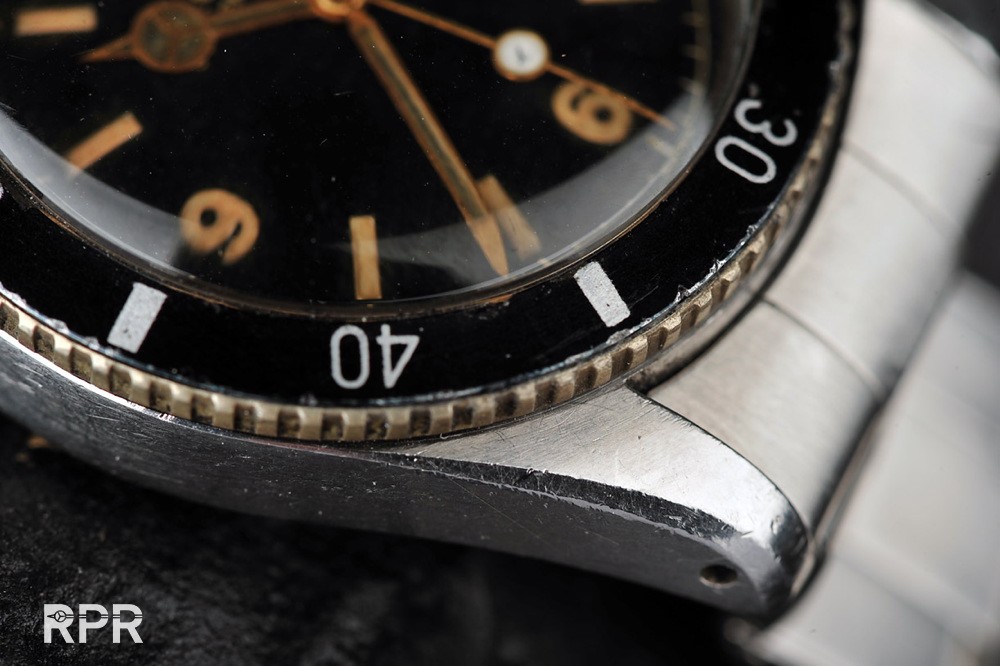 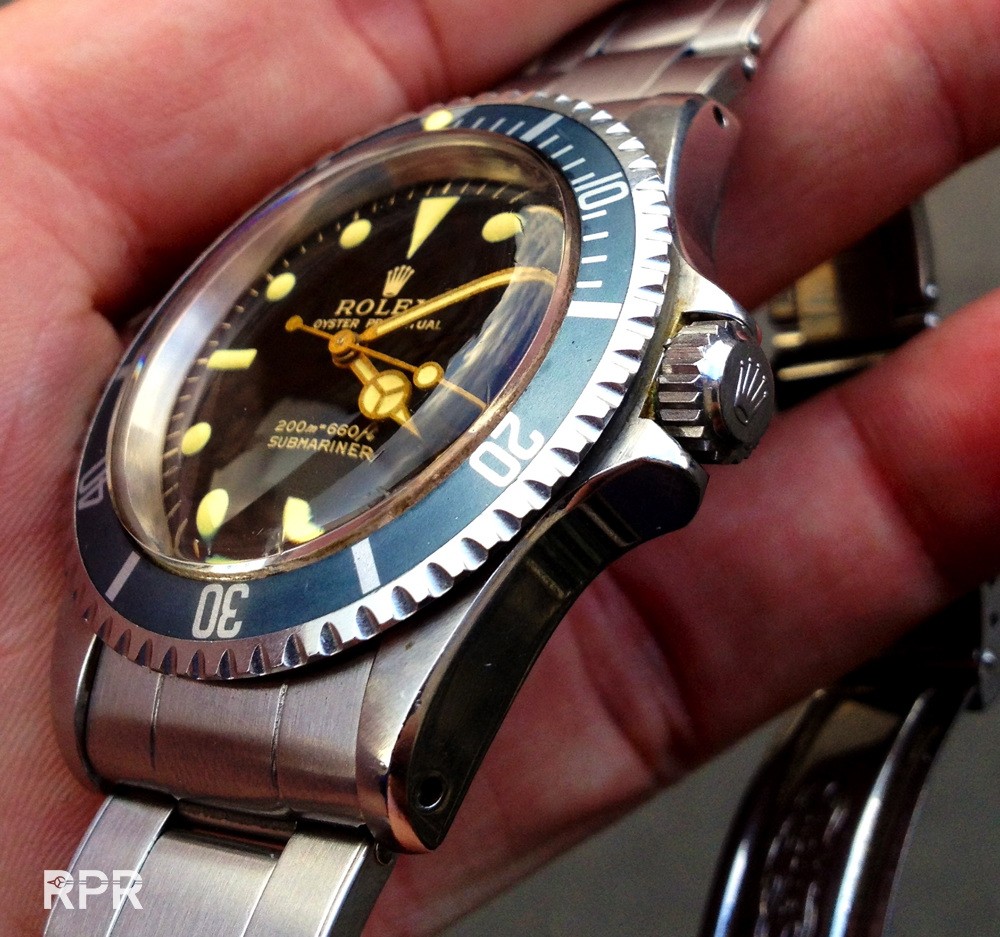 Totally fresh monobloc case seen from the back, note how sharp the rills are and the gravure of the serial and the references still are.. 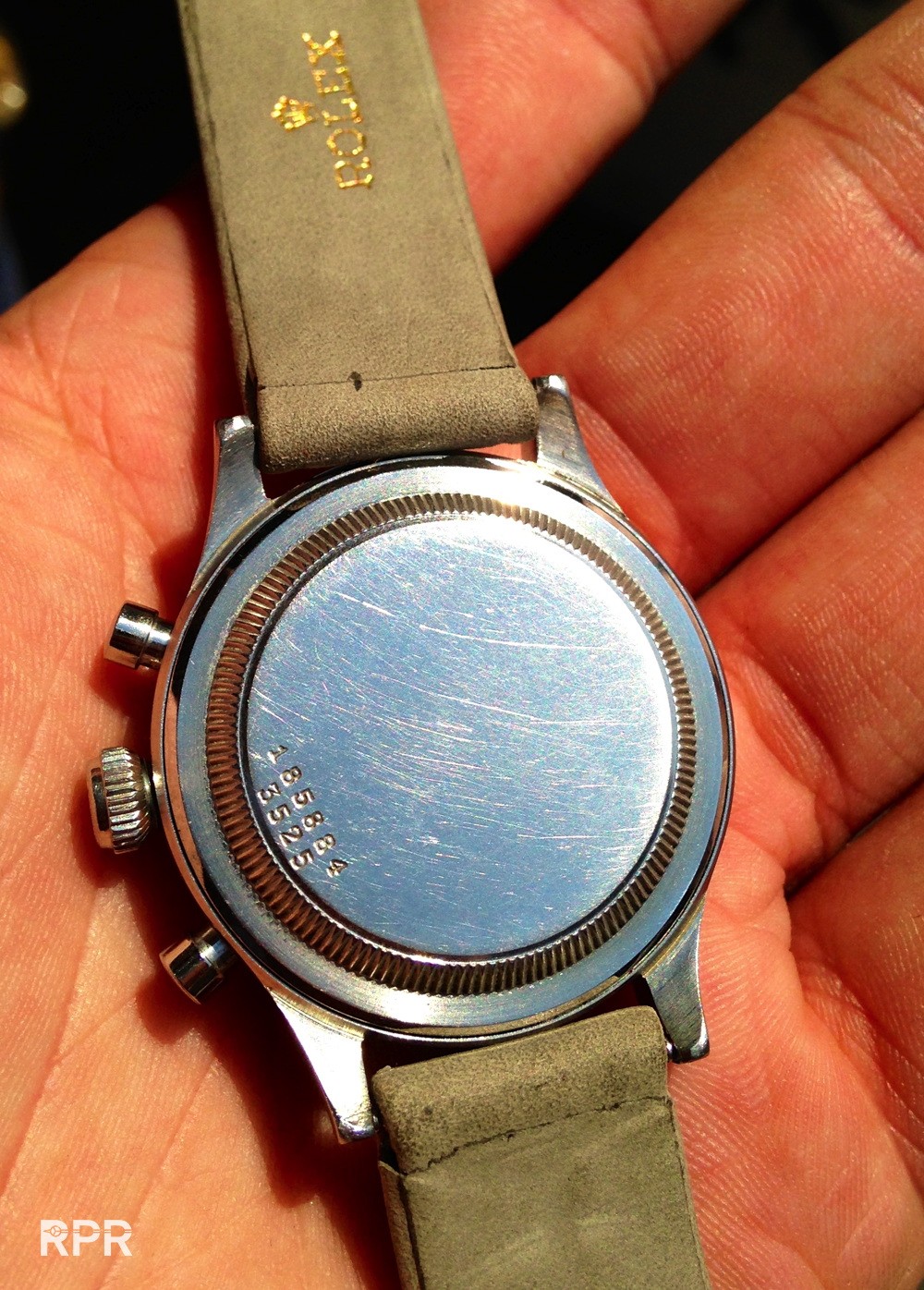 Up close you will see with a polished example that the fine lines are not perfectly straight as most likely the polished cases have been done by hand, there where the unpolished cases have a manufacture polish, done when all parts aren’t yet assembled and always the same, in 1 go. The next important feature of a polished watch is that at first the case looks nice but the engravings made mostly in the case back are worn out, polished out. Again this is what I mean with „matching all over patina”. For instance, it doesn’t make sense when the hands are luminous and the dial is not, the bezel is faded but the case looks like new or the crystal and pushers are of a later service type nor a newly fresh engraved „Asprey” stamp while the rest of the Rolex engraving is all worn out or you notice that a scratch on the case back is under the gravure while it was delivered with the gravure but now seems to be added later. Sometimes common sense will help you out when you doubt. The bezel is worn but the case isn’t or the crown and pushers are new where the case isn’t , etc. 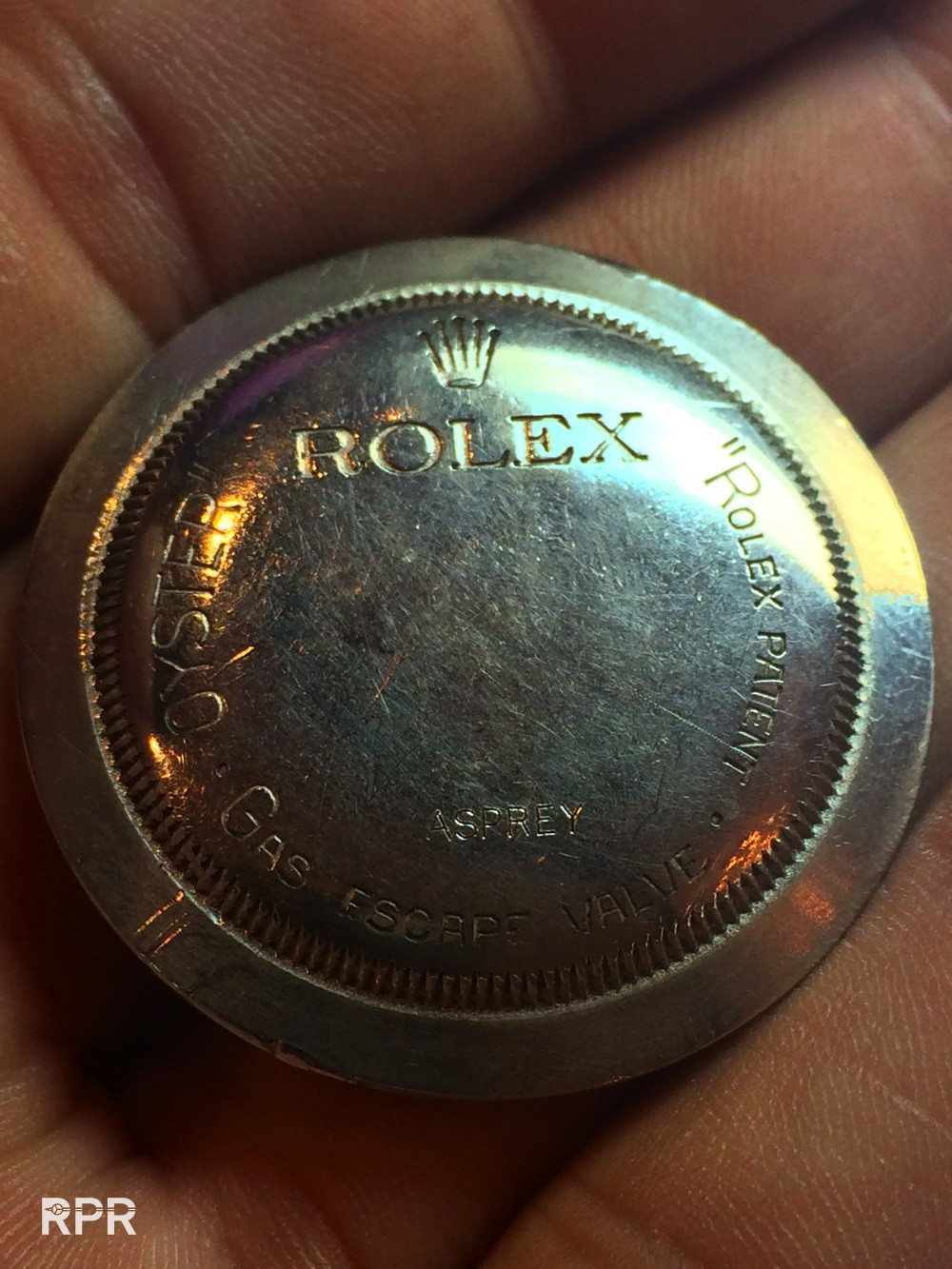 Newly unoriginal lasered Military Submariner engravings… 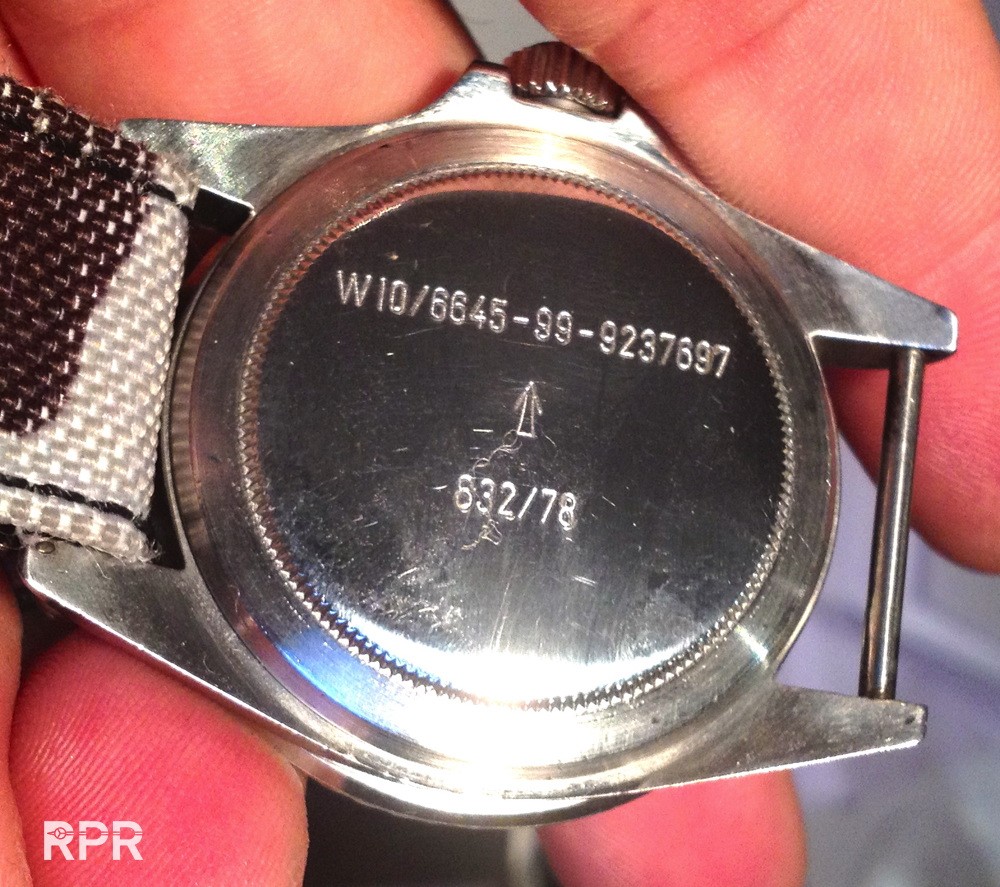 During the years many cases, specially gold ones, got hallmarks or import - export stamps. If these little stamps, mostly hidden in the back of the case lugs or on the sides of the watch, are worn out and the rest of the case if looking perfect at first view, one can easily state the case has been polished. The same we see between the lugs, where bracelets with their end links always leave visible marks. A fresh looking engraved serial number and reference number, we find with Rolex between the lugs, can point you out that the watch hasn’t been worn a lot as the end links didn’t scratch the surface due to friction. I specifically add this remark as nowadays we see cases been „laser welded” ( steel or gold is added to the worn case by laser and afterwards polished in catalogue style). Besides the part between the lugs looking ’tired’ where the case looks brand new, sometimes the push pin wholes having a different drill can show you the case had a laser job done. Here some examples of un polished cases, some showing the original still fresh engravings and hallmarks clearly… 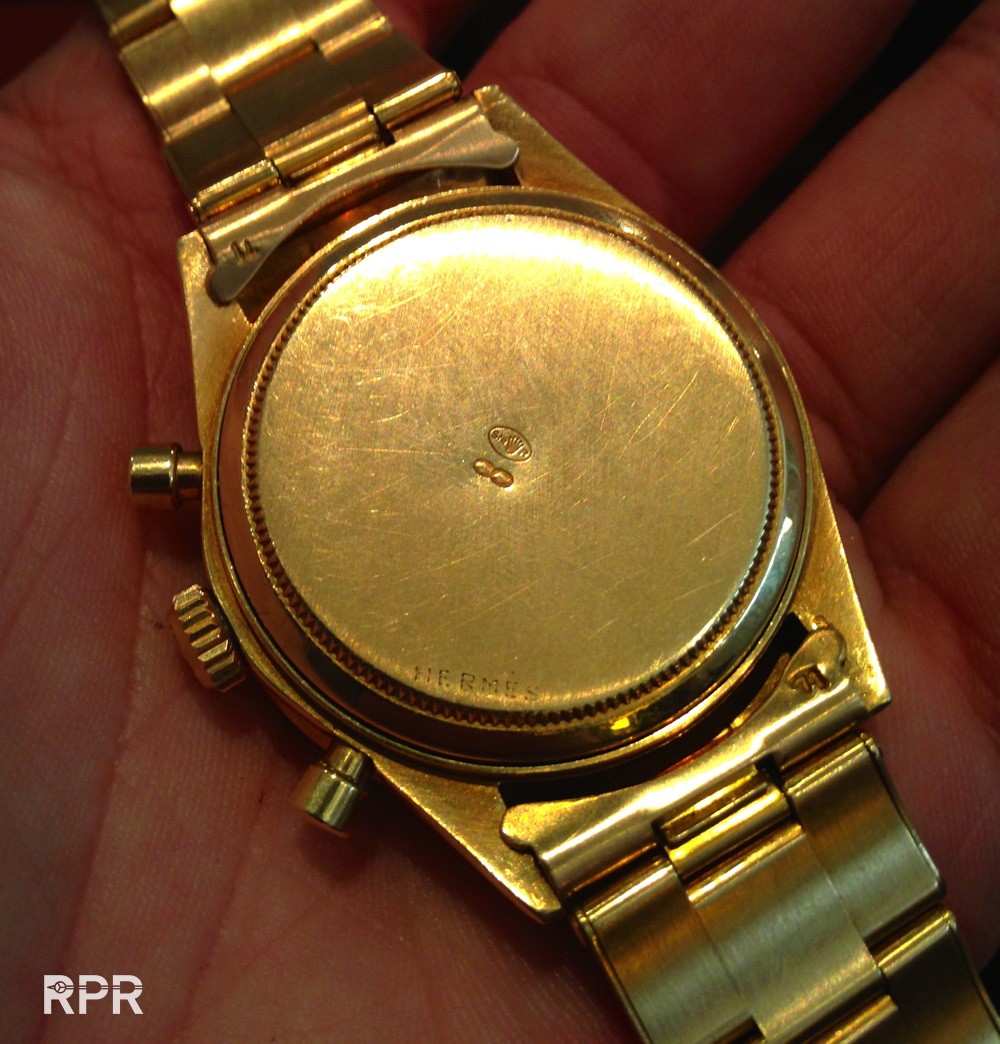 Above the french hall marks in the middle and the Hermes ( from Paris ) engraving on the side of the case back.. 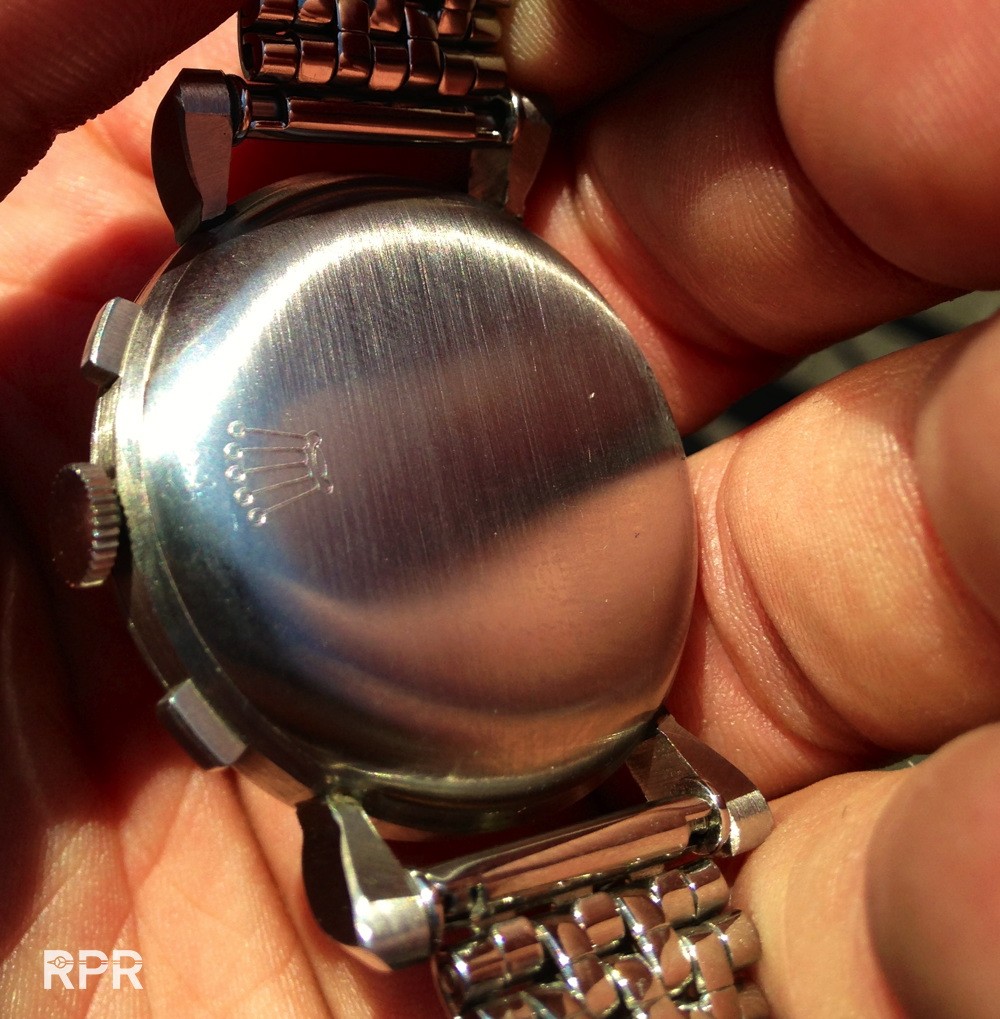 Ultra fresh and unpolished early Rolex chronograph. It’s a time capsule that seems to be unworn even after some 75 years!.. 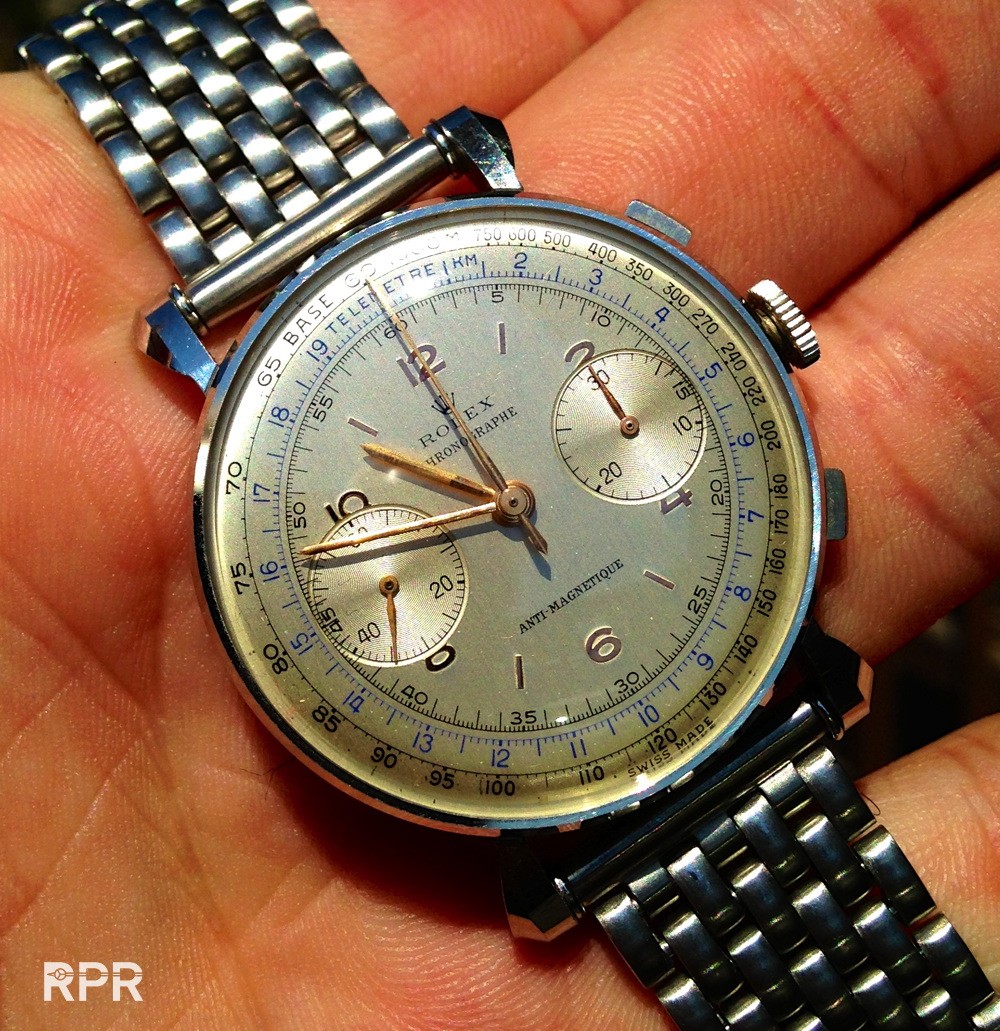 Registered Design & Model Depose engraving still clearly readable on this pink gold Rolex Killy.. 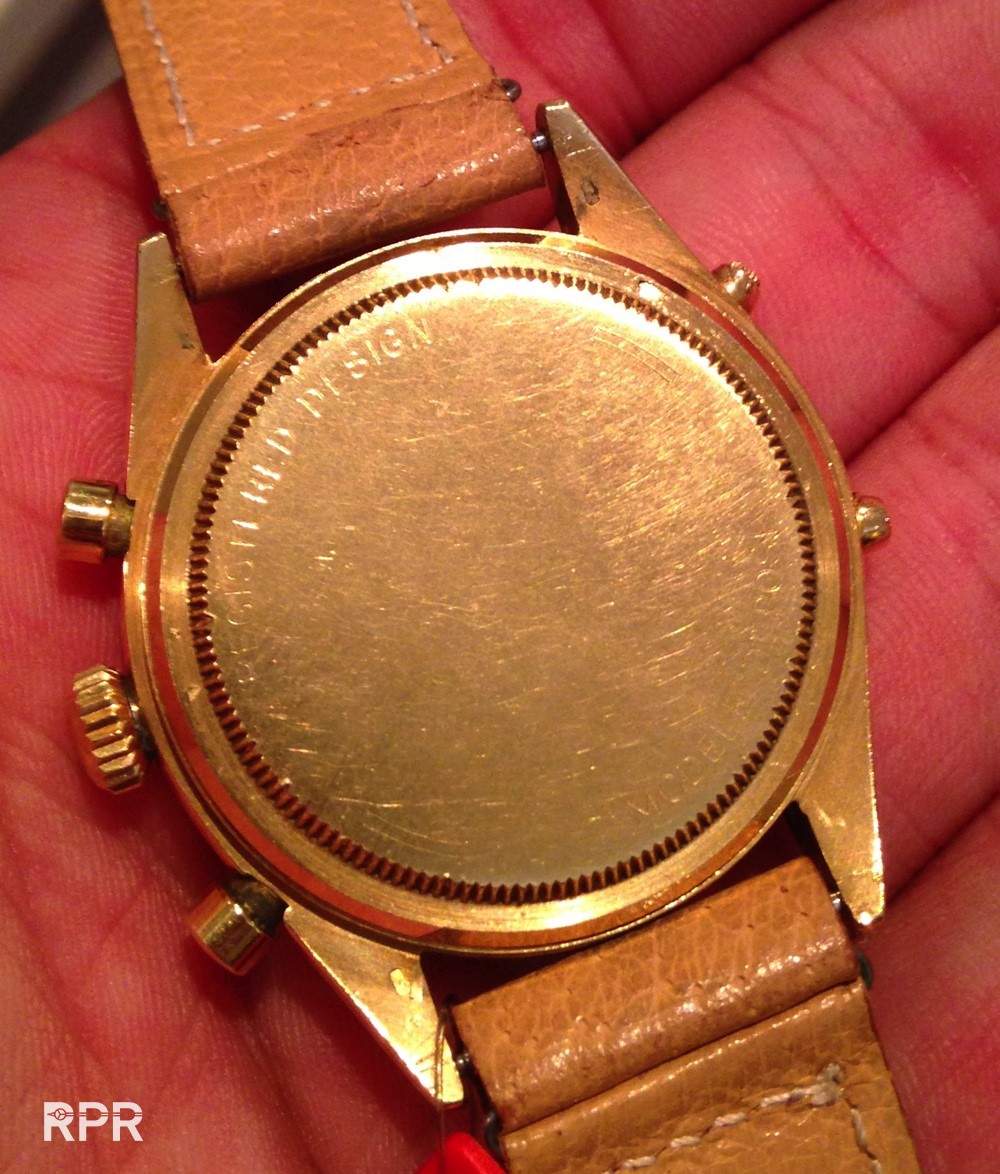 Fresh hall mark on the sides of this unpolished pink gold Padellone ref 8171… 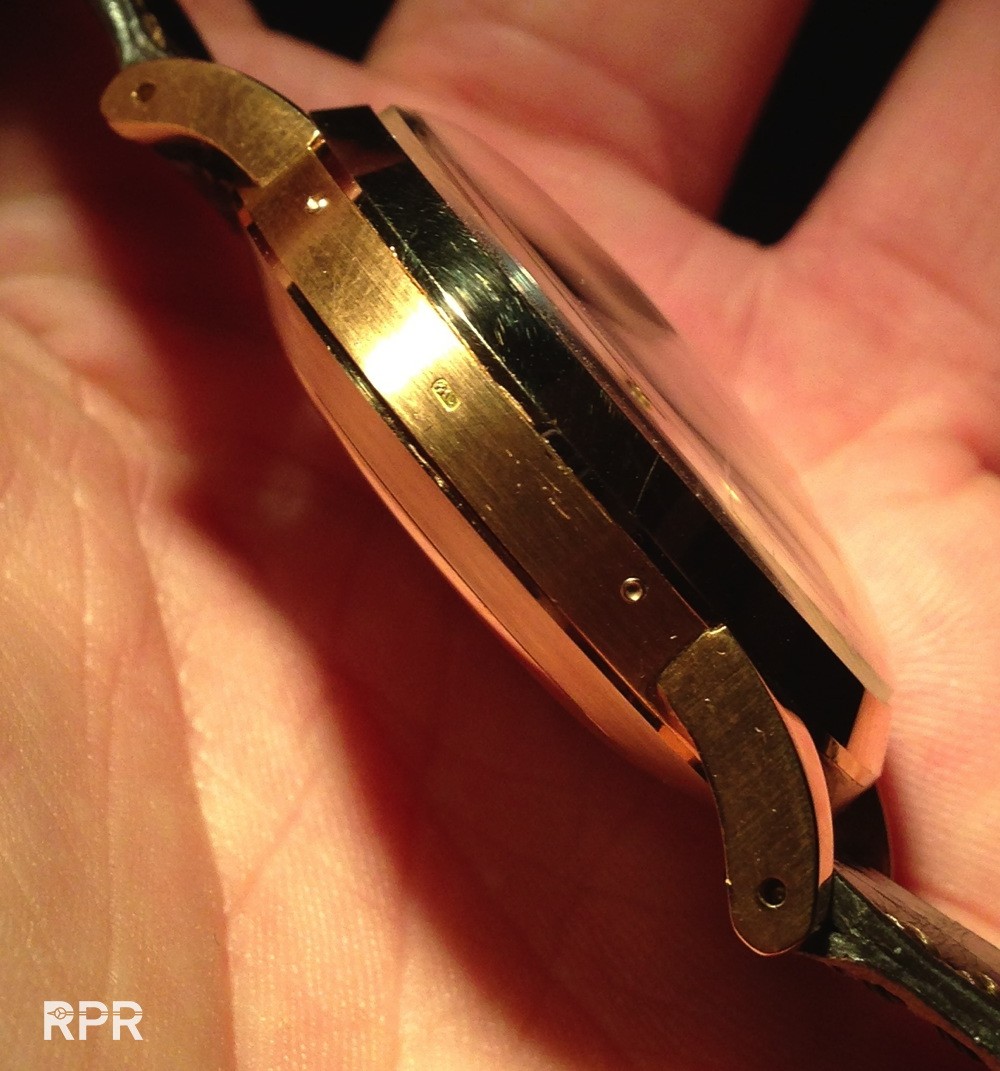 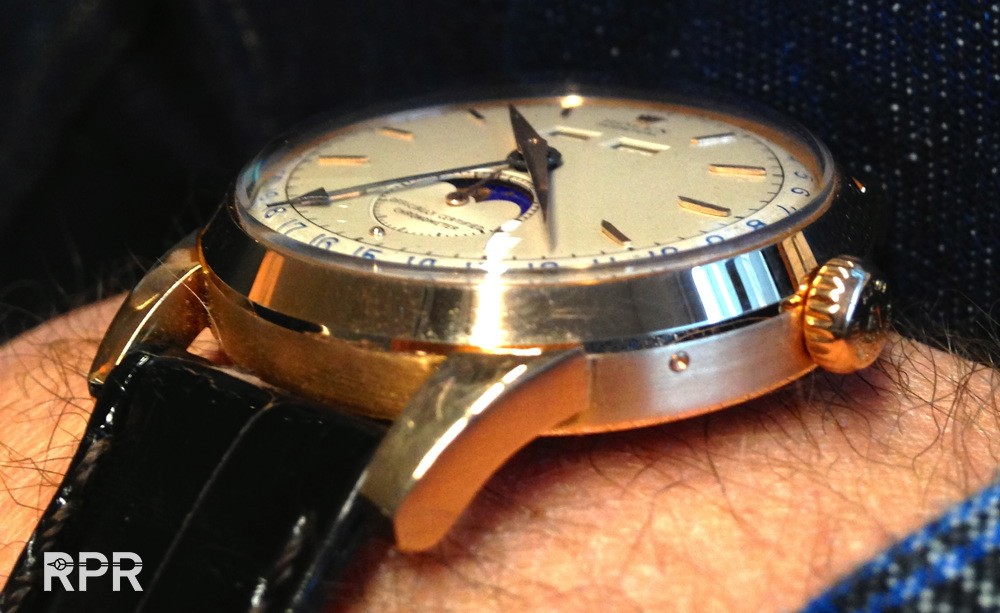 The Rolex stamps & 18 carat hall marks spread over the 3 of the 4 lugs insides.. 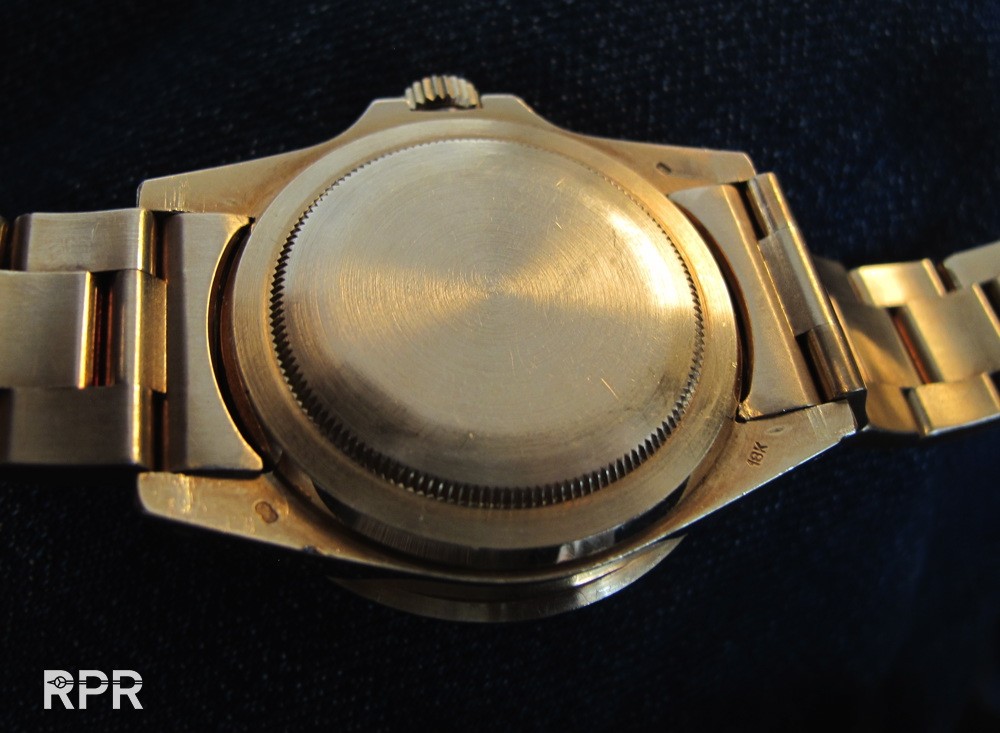 Case back inside of a freshly found Rolex 6062 stelline. Notice the small watch maker mark at 12 o’clock.. 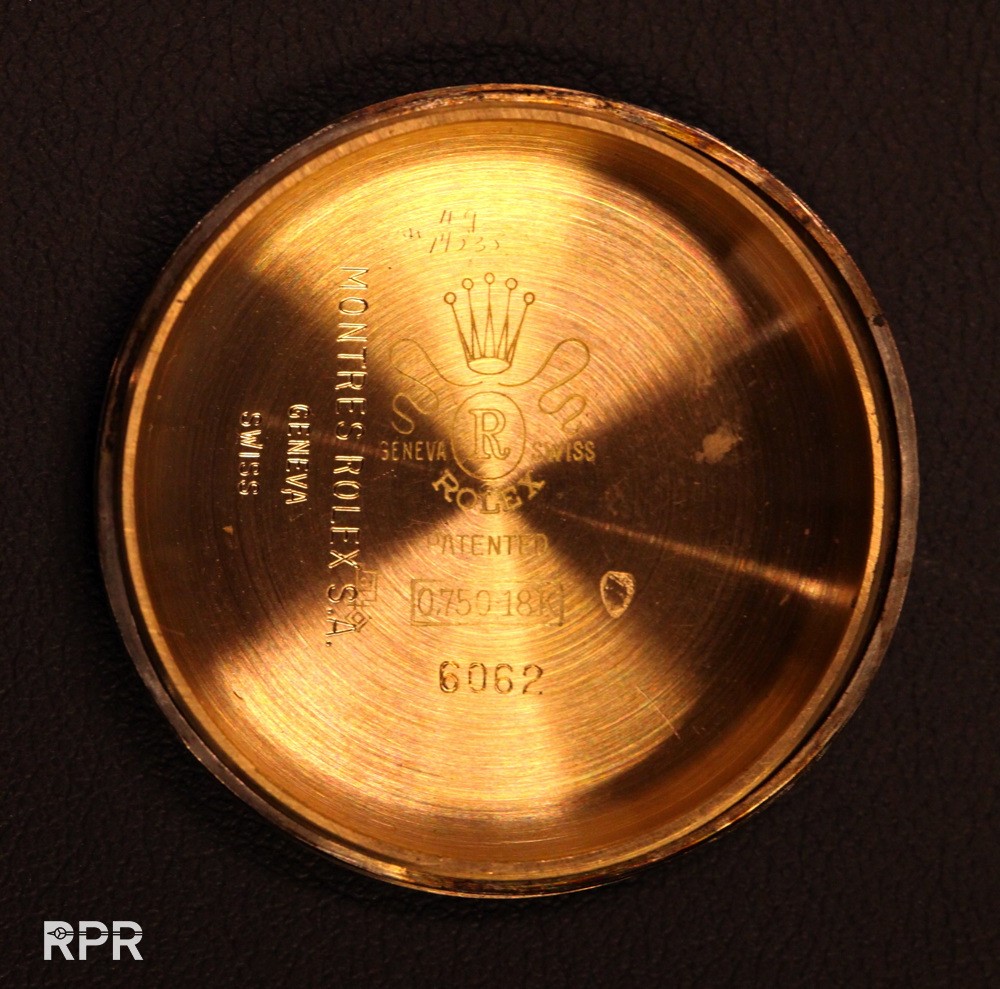 Each Rolex reference had it’s own specific Rolex logo & reference number inside their case back, up till like 1966/67 we also see the date added once left the manufactory. As most Rolex are perpetual calibers, you can spot a worn out automatic rotor leaving marks in the case back. Also individual service codes are always engraved by the watchmaker.. 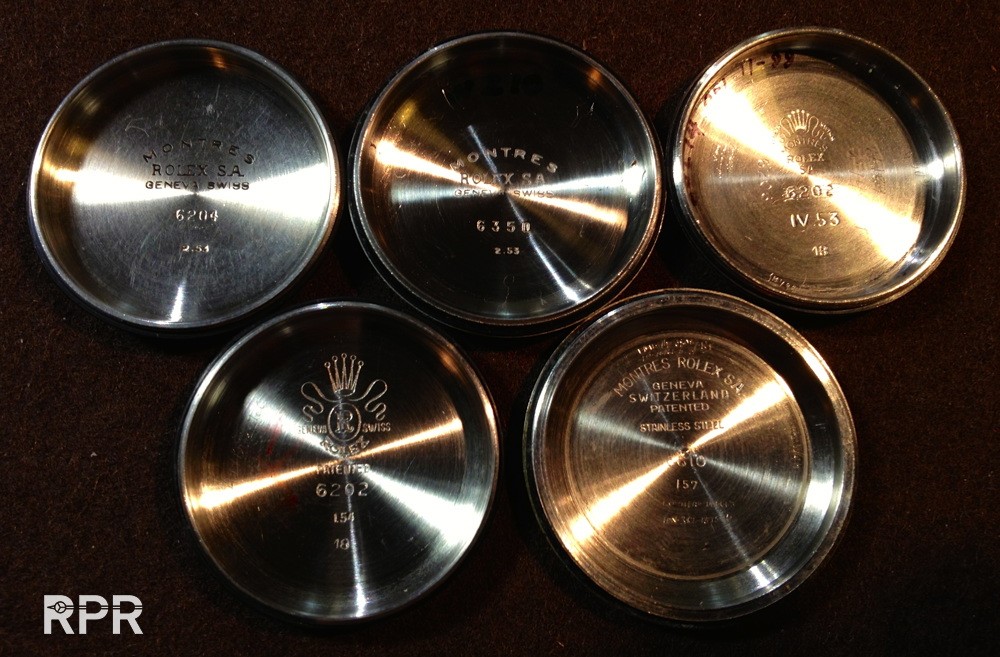 Advise: Buy yourself a professional loupe with 10 x magnify, I recommend the Zeiss Loupe you can get at your local optician or easily purchase at a stamps shop. Always loupe with both eyes opened, don’t close the one you’re not using. Never use a loupe that has an integrated lamp or violet light, it will damage your eyes. 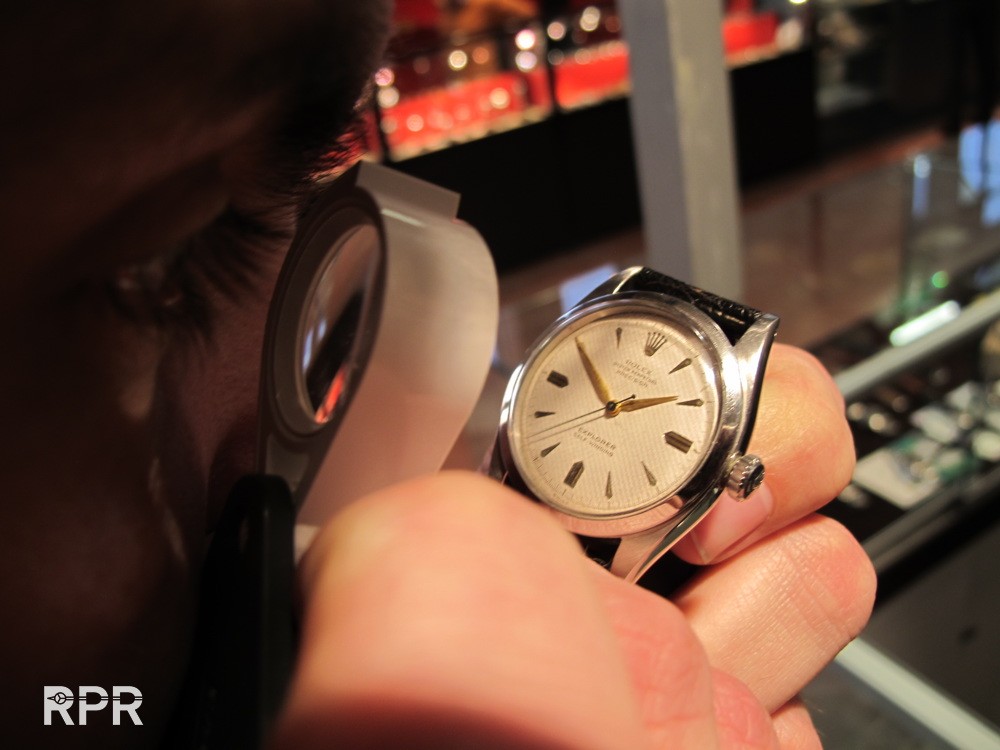 The movement has become secondary in watch collecting the last years of grande revival. Funny enough when you think about a watch, logically the movement should be what it all about. When watch collecting started long ago, the focus was always on highly complicated movements, built in pocket watches and later after WWII commonly in wristwatches. We still see that the old school collectors are merely interested in a rare version of hardly seen complication but generally the new way of collecting has changed dramatically. Now it’s the face and it’s uniqueness next to the preservation that became popular. New buyers enter the market and are solely interested in building up a collection of very nice looking, iconic wristwatches.  The push in price we noticed on the Daytona since some 2 years is amazing. A Paul Newman Daytona or Killy DatoCompax using a non Rolex modified Valjoux caliber have broken every record. There where an iconic small or big crown Submariner, Milgauss, Explorer, Day Date or GMT master with in house Rolex manufacture movements don’t reach the same level yet. This will most likely happen soon because Rolex’s innovative spirit and magnificent heritage lies in the references that are totally designed by them, including the movement!.. 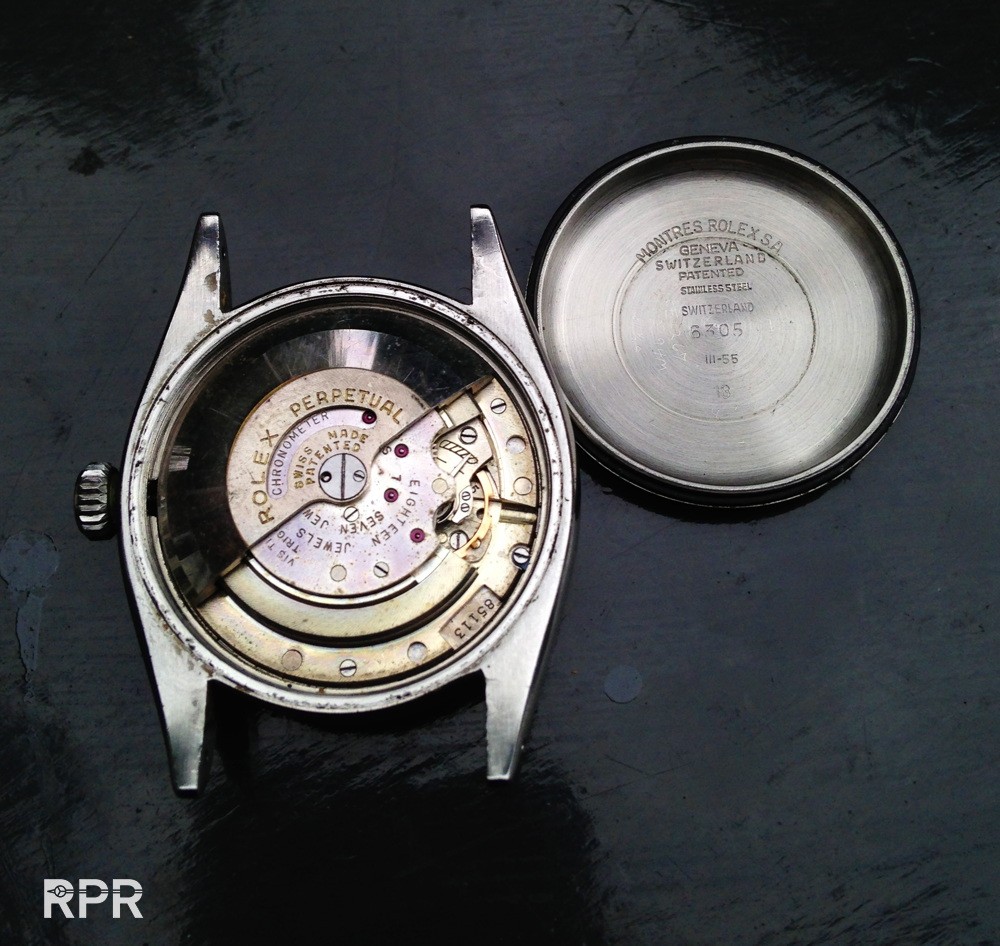 The patina on the top of the movement should match with the rest of the watch, if you see a clean case, most logically the movement will also be clean when you open the back. My tip is to check the most commonly used parts up close and see how their condition is. With other words, to get the movement out of the case one needs to unscrew the crown and the movement plates at the edge that are holding the movement tight in the case. When you notice that the screw to release the crown, mostly located near the 3 o’clock opening where the crown goes into the movement, is damaged on the surface, it means it has been taken out a lot. A not so precise watchmaker probably used the wrong screwdriver and damaged the top of the screw and the surrounding of the plate. The same you check with every screw visible from the top. Water damage will oxidate the movement making it look brownish and dirty. Here it helps to analyze NOS ( new old stock ) movement pictures to get an idea how they looked like. As most Rolex are waterproof, using the Oyster concept, the screw thread thats attached on the case back will reveal you heavy use or not. Any watchmaker who serviced a watch made his marks engraved in the case back, spotting many of those individual codes will tell you it has been serviced a lot. 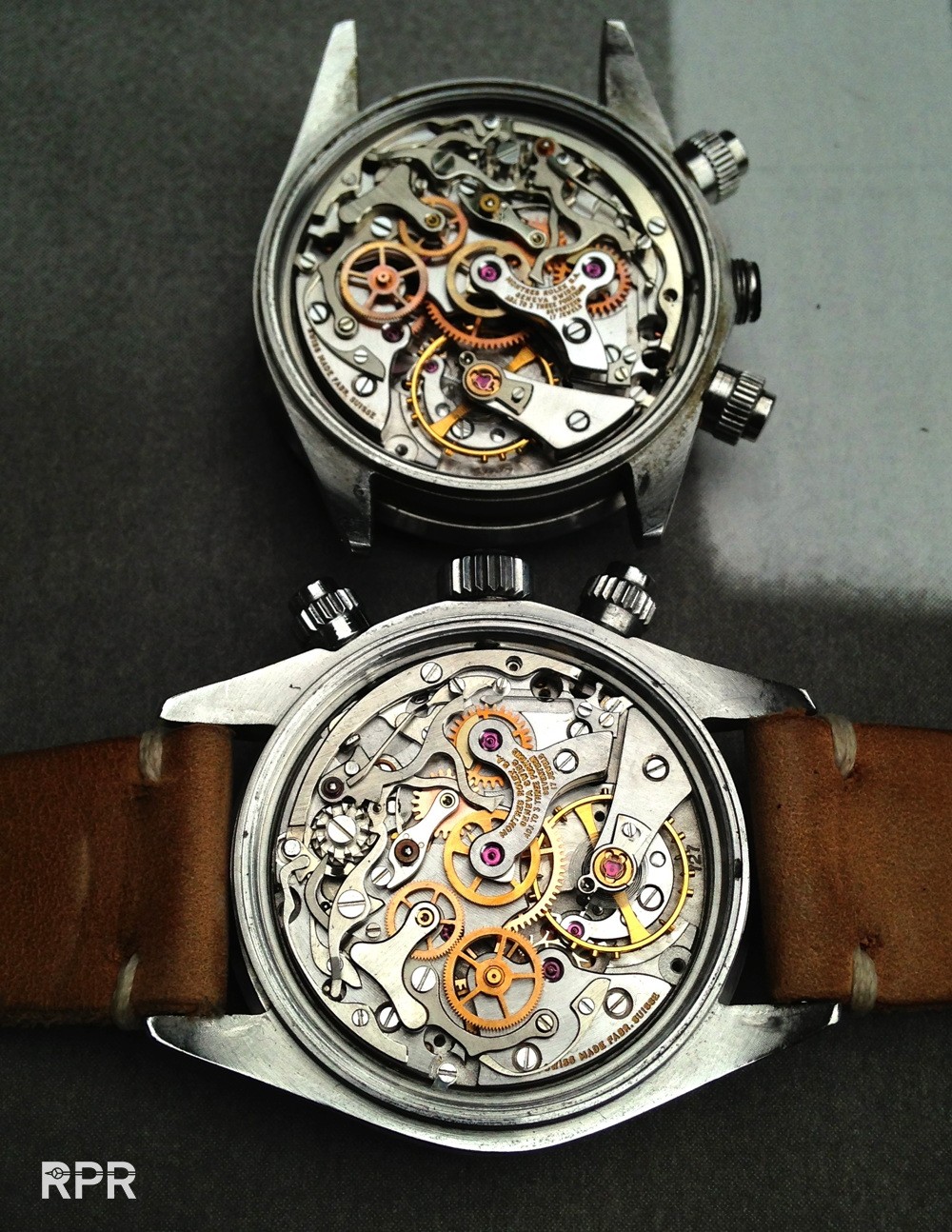 Below Submariner movement, caliber 1560, is still having it’s original rotor.. 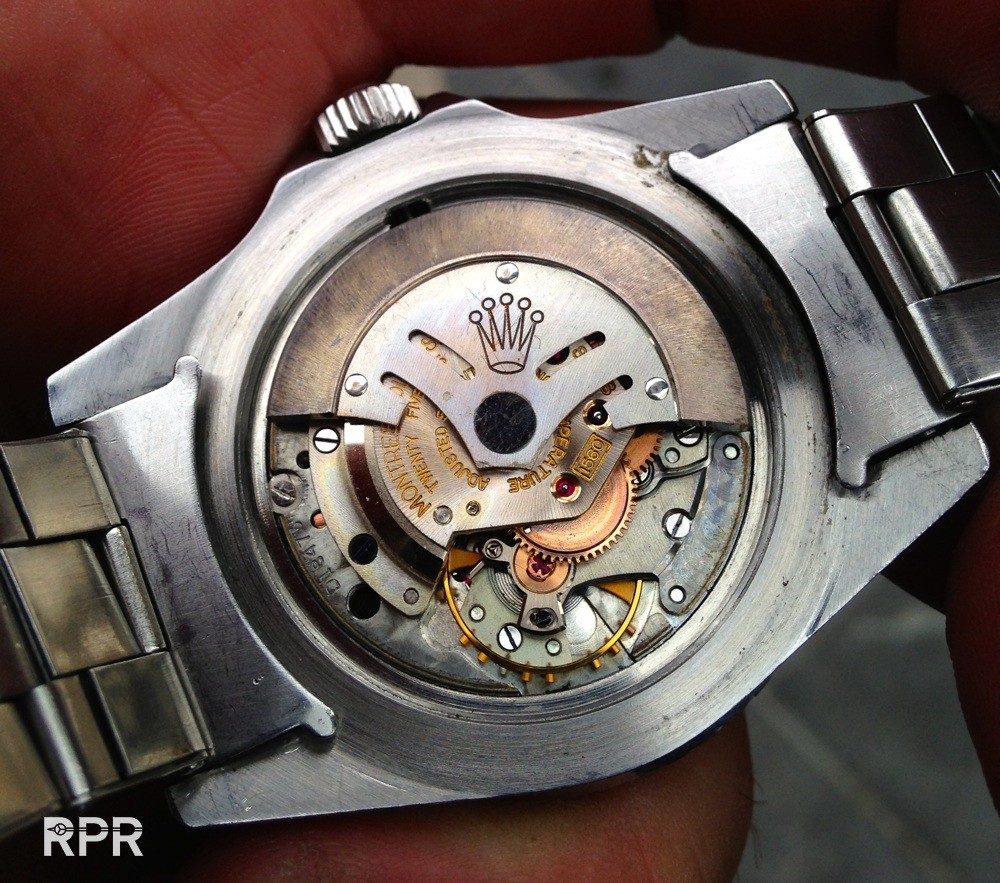 Then last for today but certainly not the least interesting, fake parts. Many collectors have experienced that a so called great deal turned out into a nightmare. Since many years the collectors market in general has been overloaded with un original, later produced, counterfeit practices. As modern watch collecting has become all about the dial, we see many creative crooks trying to enter the market of big money. Reproducing a dial in all it’s details is becoming better and better, even to a degree where it’s almost impossible to determine right or wrong. It’s improving so fast, due to the use of modern technics, that one should remove the dial out of the case ( with all risks of damaging it ) to be certain if it’s a original one or not. Magnifying it up tp 100-200 x and comparing with one thats proven original isn’t possible for many collectors. Therefor buying from a trustable source where returning a watch with issues is never a problem, has become highly recommendable. Often when a deal is to good to be true, something is smelling fishy. Be aware and try to train your eyes to notice every small detail that’s not like you’ve seen before. Question every difference, ask fellow collectors or post your picture in a watch forum online before making the deal! See below a fake Rolex Submariner dial, where the printed graphic is becoming very close to original. If you doubt buying from pictures, always make sure you see the watch in your hands before finishing the deal. Once you’ve handled these fakes, you’ll notice that the patina is wrong. In those cases your eyes tell you the dial seems to be ok at first look but when you examine it up close, with your loupe, your brain is warning you to be extra careful as something is not correct. 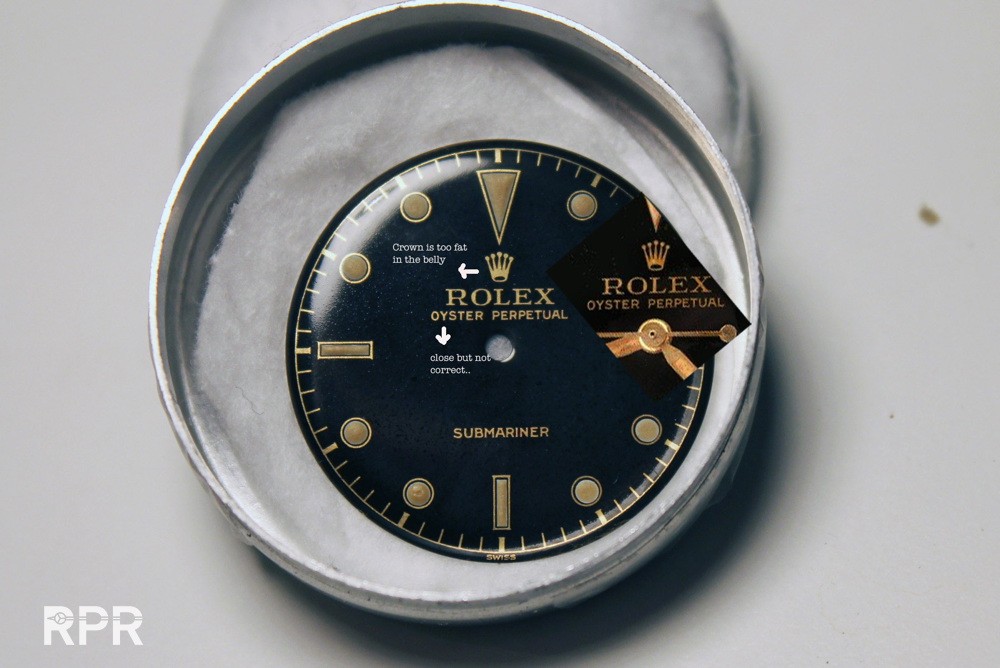 Same as above, the print is almost spot on ( compare it yourself with the 2 original cut outs I added on top of the picture ) but the patina of the laquer and the luminous are new and the dial has hardly any radiation although it’s a mid 50-ies Rolex design that originally is having a strong radiation. Be aware!! 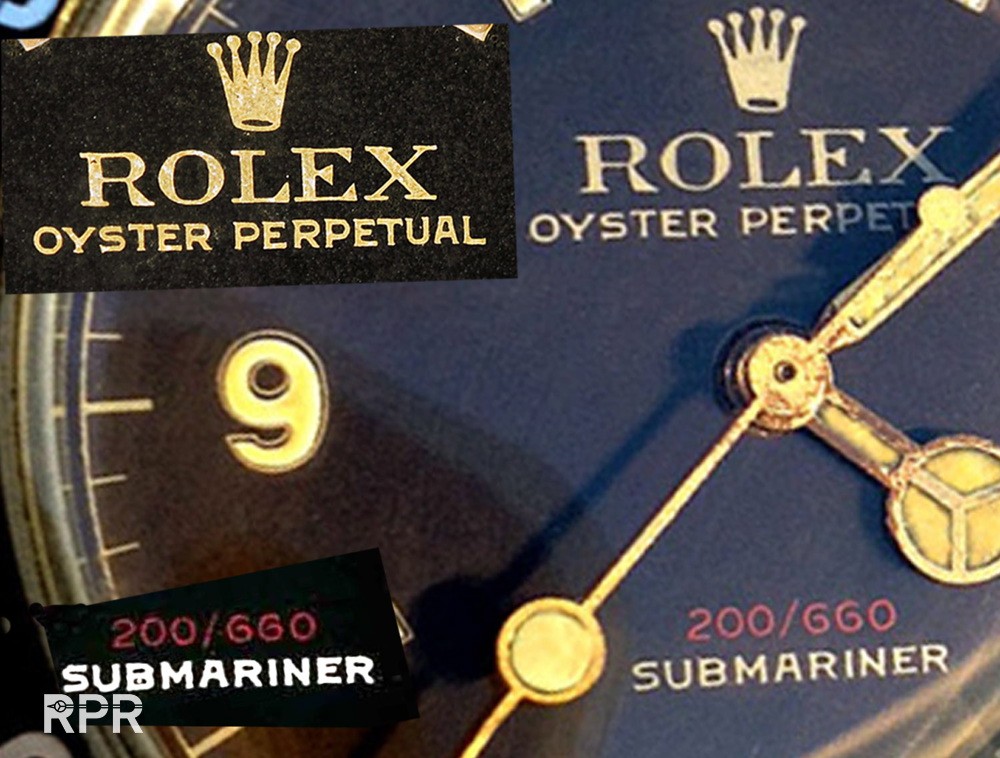 Below we see a original Radium Submariner dial where the aggressive radium dust has eaten up the top layer of the finished dial.. 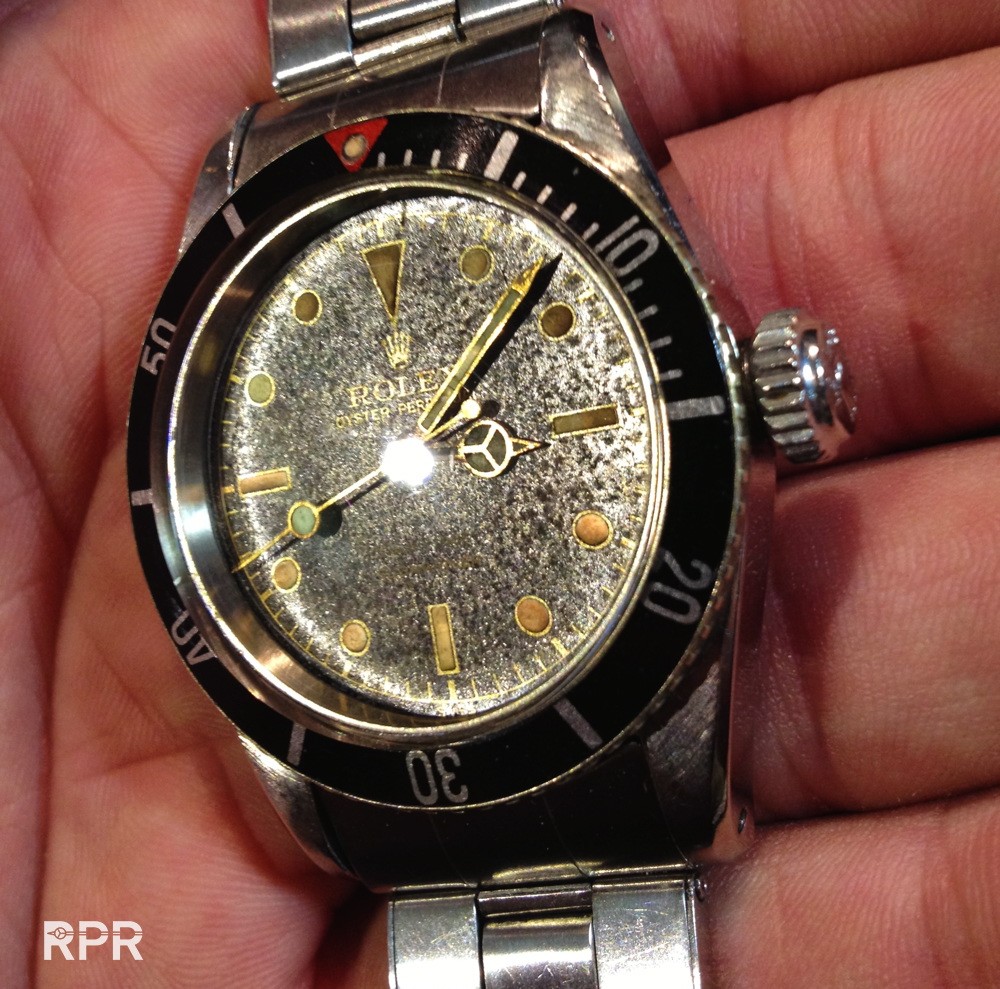 In below picture you see clearly the way of printing that this glossy minute track Submariner Ref 5512 with SCOC text. These last 2 lines are added on top of the already finished laquer, there where the Submariner & 200m=660FT, is below the finish.. 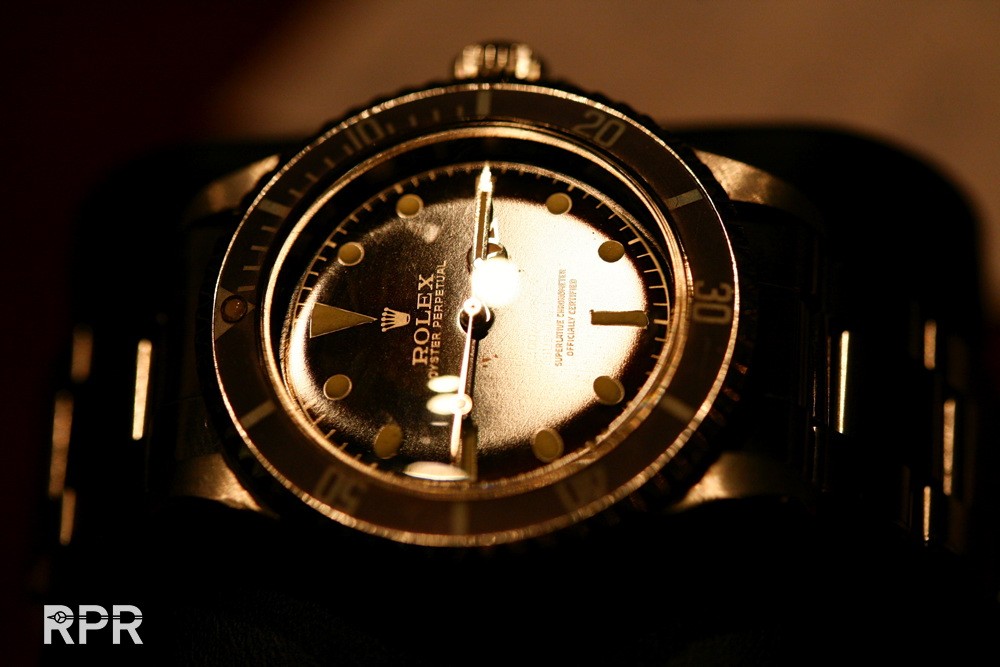 Ok, now lets analyze 2 x examples with the knowledge from above. What do we think has happened to below pictured Submariner Ref 6538? Look closely and try to answer yourself before you scroll down.. 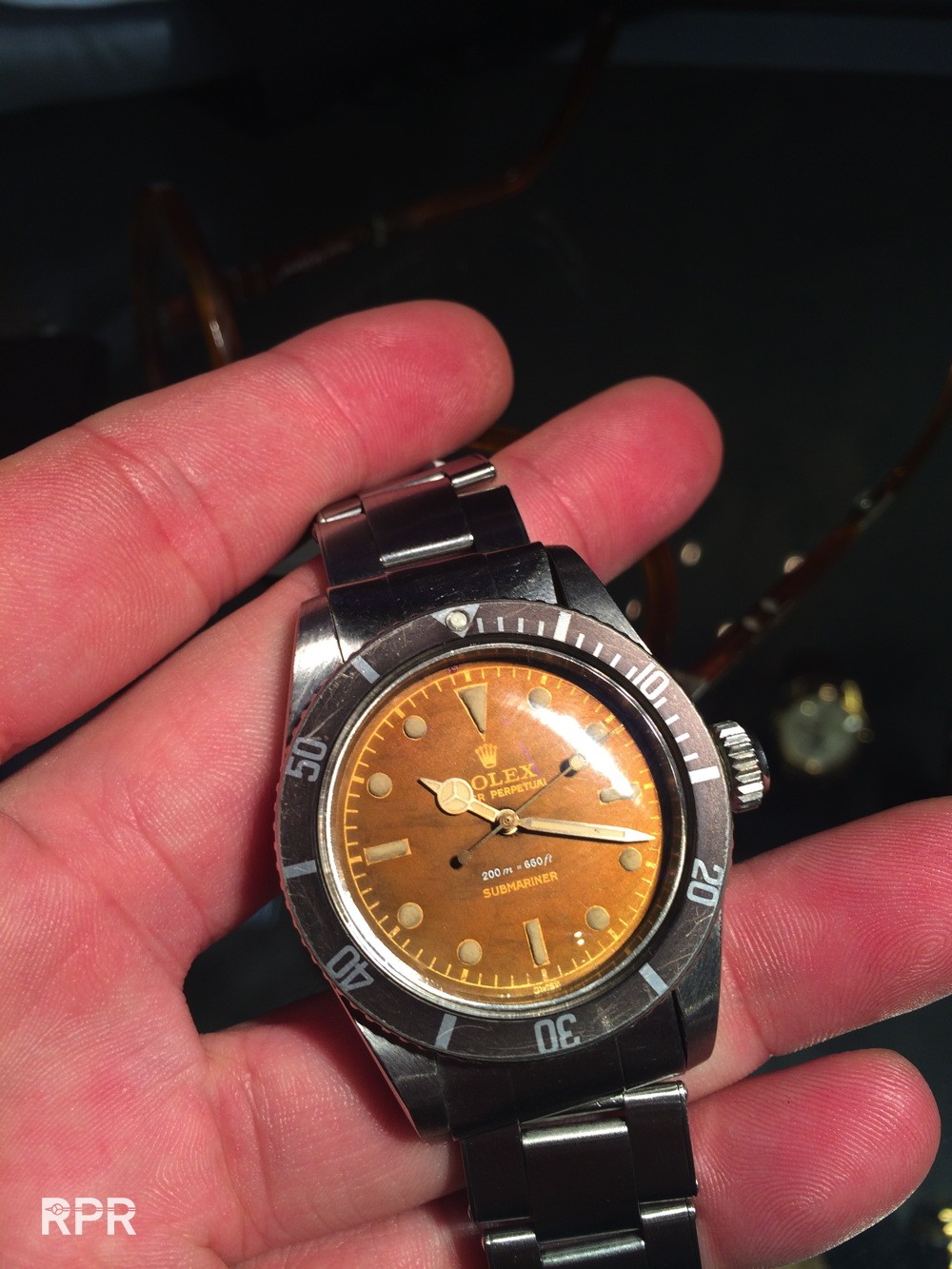 As always, first focus on the luminous on the dial and that on the hands. We clearly see that the color in the hands is much lighter then the color on the dial, so this immediately tells you: something has been done to make it look nicer. The hands in general have a bigger amount of luminous than the dots on the dial, besides that, the luminous in the hands does not have a surface compared to the dial. Therefor generally speaking hands tend to change later in color then the dial. What we see is just the other way around, besides that, the hands are to small as the minute hand is not reaching to the minute track but stop just before. So at first, your alarm bells should already have gone off, something is suspicious, hands where not those that where born on this iconic Submariner. Next we look carefully to the luminous on the dial, in specific at 3-6-8-9 and 12 o’clock. We notice that the radium lume ( swiss dial ) is not perfectly added and hanging over the gilt lines printed on the dial. As Rolex always have done this perfectly it means it’s not Rolex, done afterwards. SO besides the hands, the luminous is also not original as we want to see it. Fact is that the dial has gone tropical, from initial black to brown caramel. As the lume on the dial is renewed professionally the discoloration of the dial has happened due to a moisture problem and not due to heavy UV light and long storage, so in other words, it’s a damaged dial that got cosmetically enhanced to fool people. The next one, a 4 line Submariner small crown ref 5508. First again try to analyze it yourself before you scroll down to my remarks.. 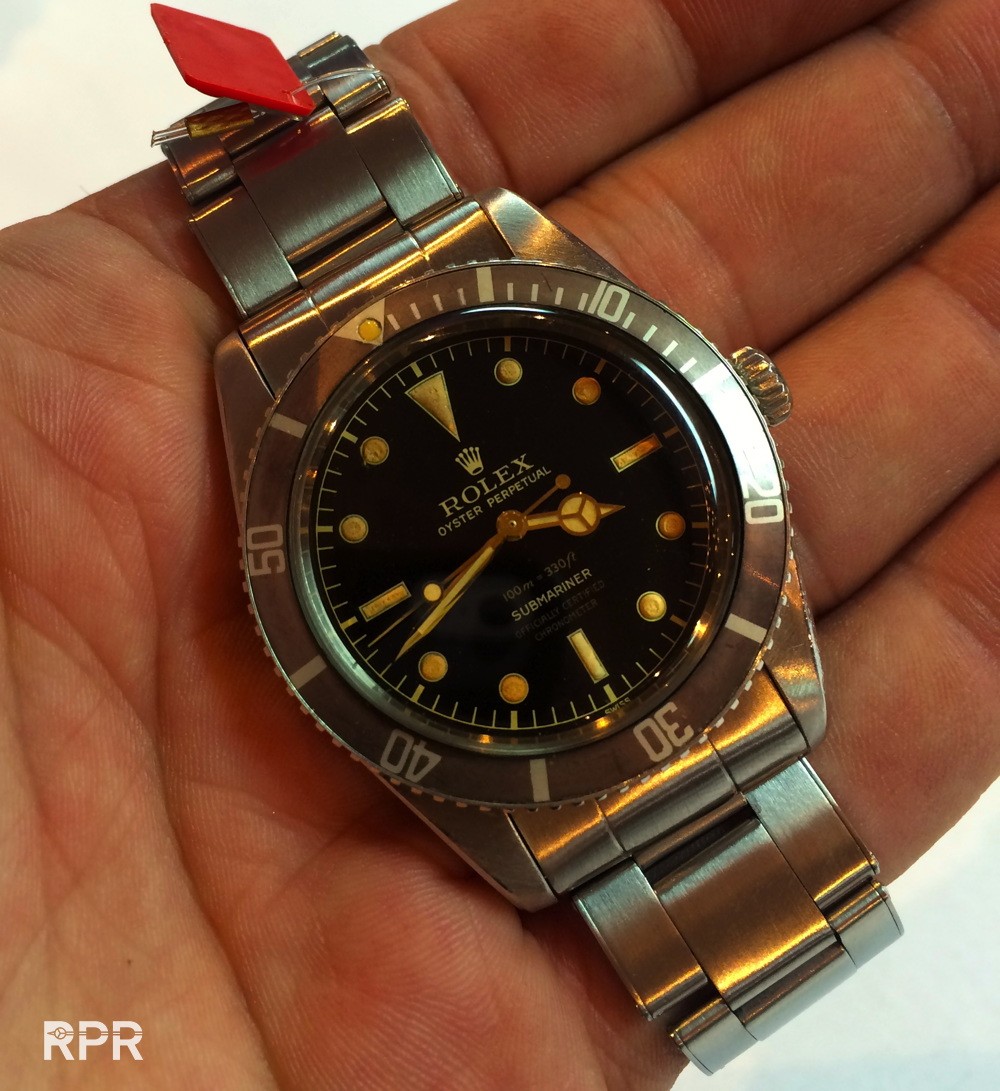 We start as usual to check out the color of the hand & dial luminous. With this one the both colors looks seem to match at first sight. But once you focus on the hands you see again that they are to short. Minute and second hand are not reaching the minute track on the outside. Besides that, given the fact that this is also a swiss radium dial, we don’t see any corrosion on top of the gilt hands, done by the radium dust. So again, your alarm bells should ring by now. Next we inspect the luminous up close on the dial, we notice that the top layer of the luminous dots have lost their rounded structure. Actually the top have been scratched of to remove the stains that where there initially. As the lume is the moisture meter we’ve learned, in this case the moisture has entered the inside and got sucked up by the luminous making it turn brownish black in due time. Many watch makers in the past almost automatically removed the top layer of the lume making them look like craters. So besides the hands, also the lume on the dial has been touched. Then we focus on the case and the bracelet, we see that the small hairlines are not consistent and the color of the steel is all over much too bright looking, meaning it’s recently polished, with other words, prepared for sale. The next Big Crown comes from recent Geneva sale from the market leader Christie’s. What do you notice?… 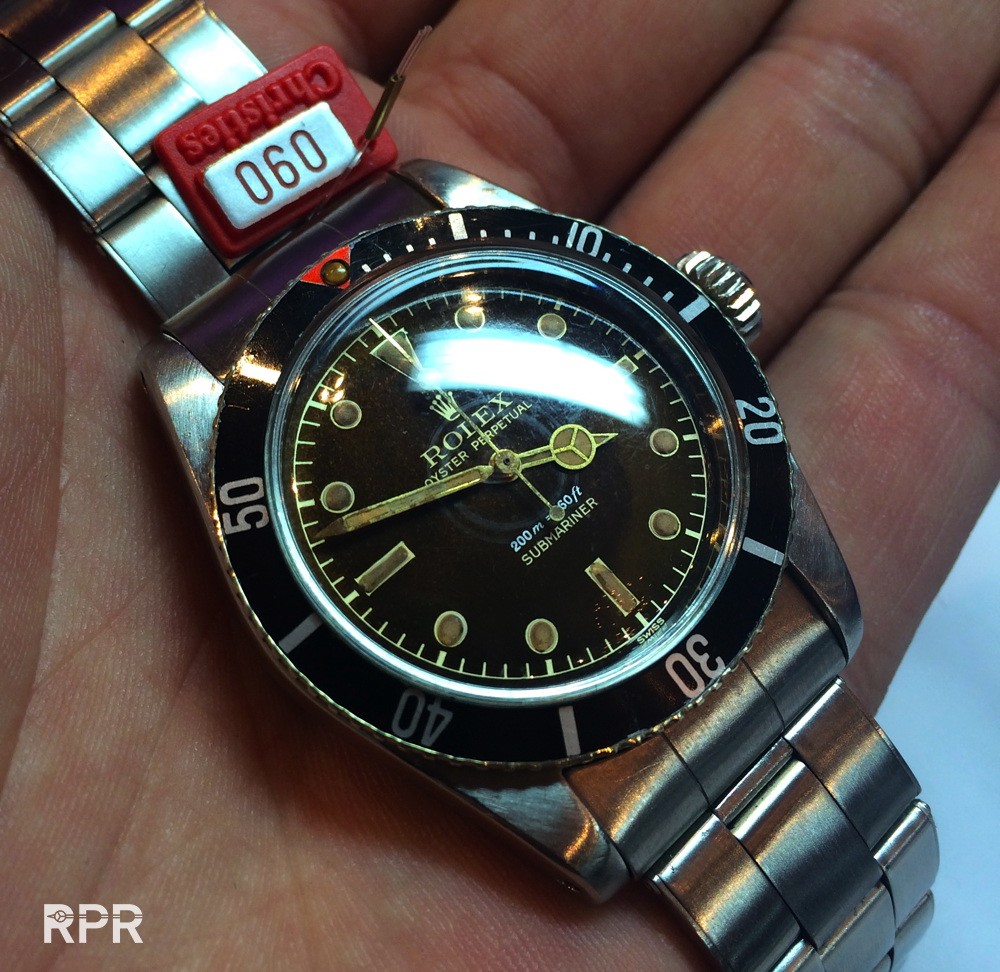 It’s about the same story as on the first tropical brown Submariner we analyzed up here except the hands look to be more matching. Why I bring this one up as a example to discuss is that if you where a buyer and you would only trust the pictures published by Christie’s online and in their catalogue, you would never had seen that the middle of the dial shows circular damages. This is due to the fact that the hour hand was pushed to hard while placing it back and then slowly damaged the surface of the dial. The glossy lacquer is irreparable. I strongly advise you when you want to buy at an auction, always to make sure you check the actual watch ( preferable in daylight ) before the sale starts. The enormous amount of photoshop done is a thorn in my side. It’s cheating with the trust they have earned by becoming market leader imho. I honestly think all auction houses should stop using photoshop. To rest my case, following pictures is of an early 1956 Big Crown with 4 lines coming for sale in NY soon… 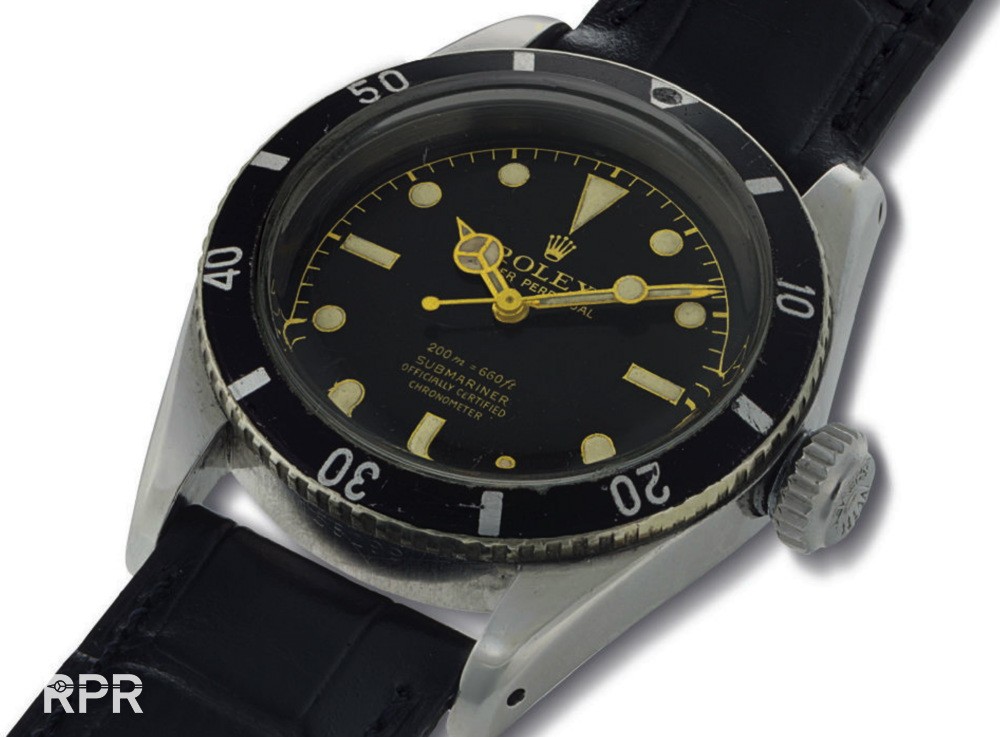 Now compare it with below picture recently made by iPhone and you see the above is all photoshopped. Even the typical greenish 6 o’clock index we see on early sports Rolex from 1954-1957, has become the same color as the rest of the luminous on the dial. Over sudden the whole dial is also equally black. 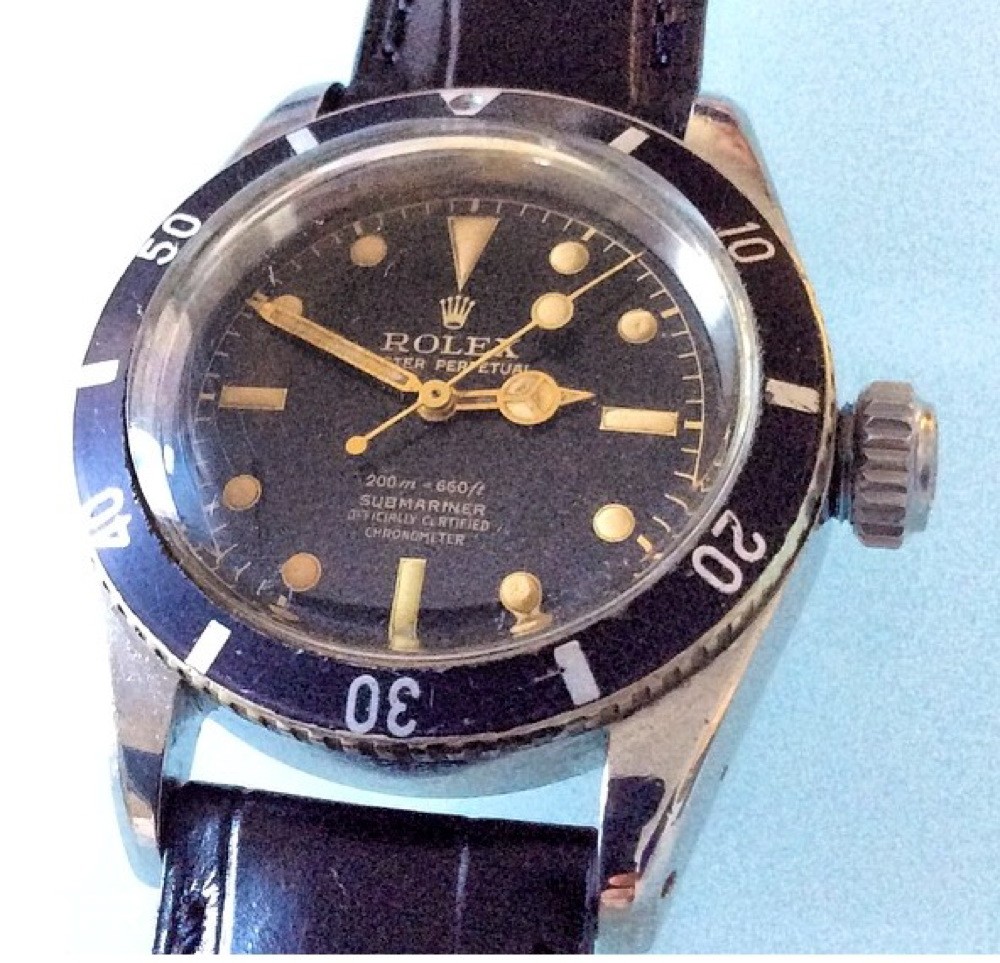 Advise: Use the enriched information from John Goldberger’s „Vintage Rolex – 100 superlative Rolex Watches” Application for your mobile. Besides the all the information from the book, there’s a section with close ups from the movements, case backs and dials! An absolutely must have for any serious watch collector and Rolex lover in general. It’s regularly updated with interesting data of newly discovered Rolex that come to the market. Check his website for possible Ipjone & iPad applications on Rolex and Patek Philippe over here: www.johngoldbergerwatches.com 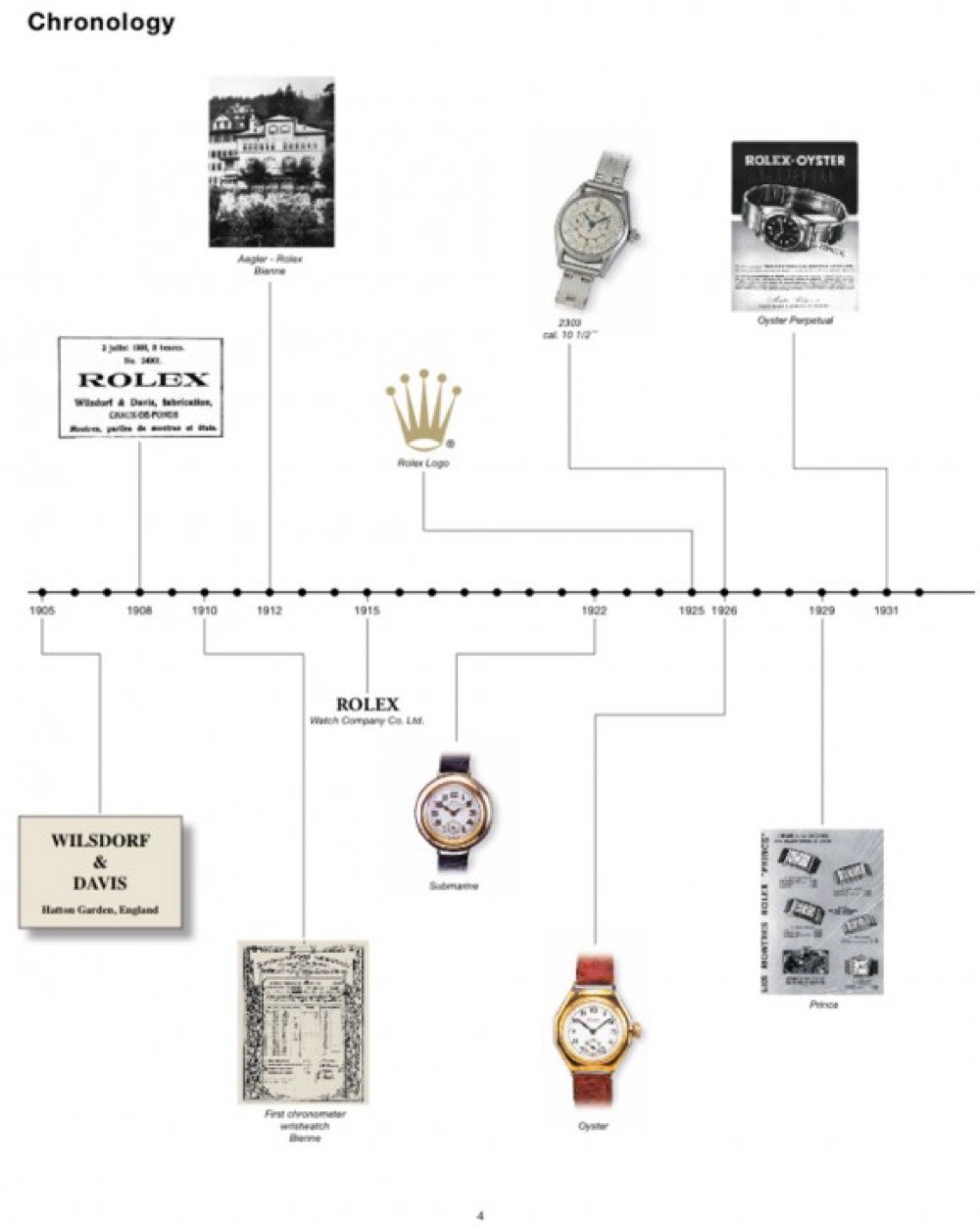 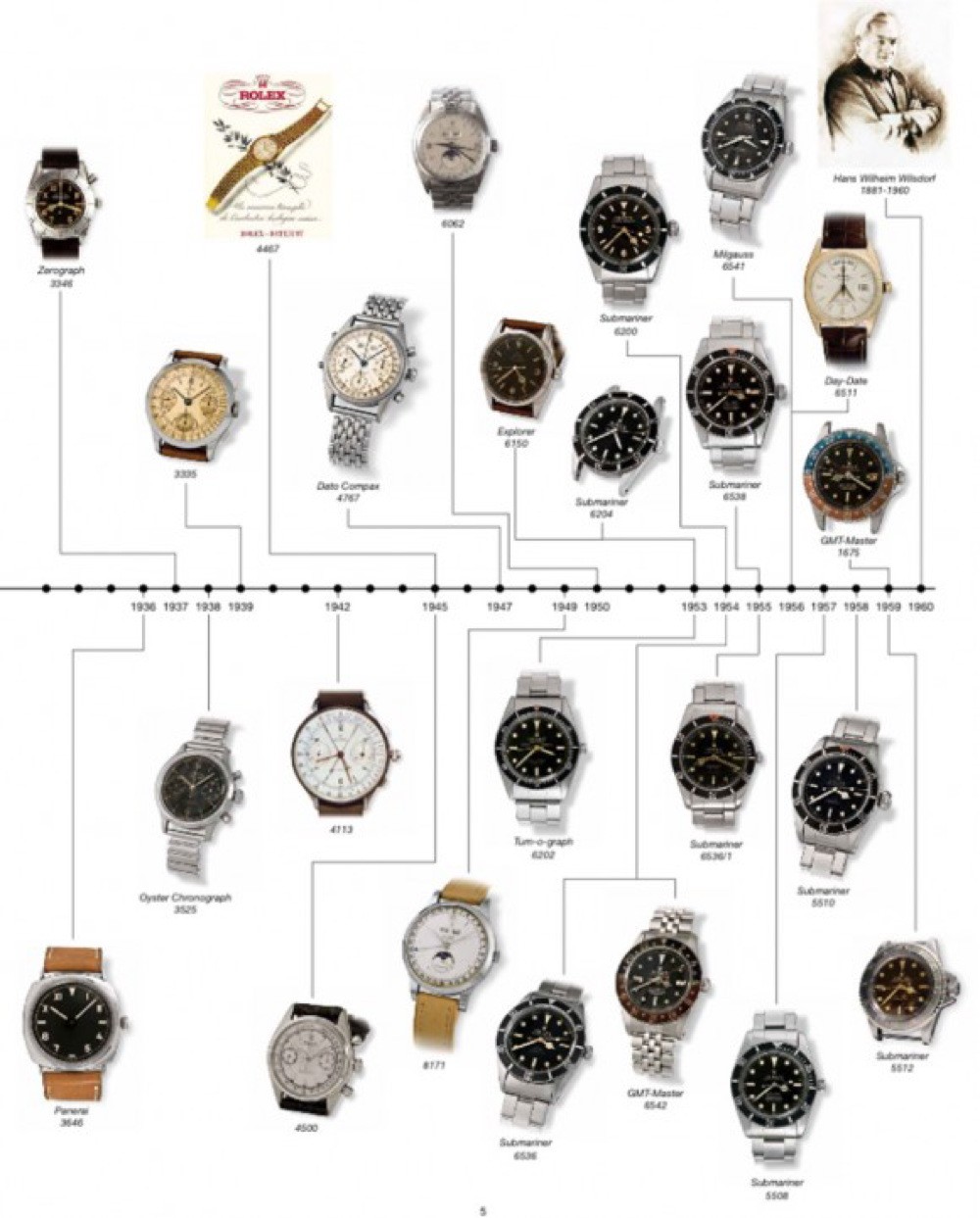 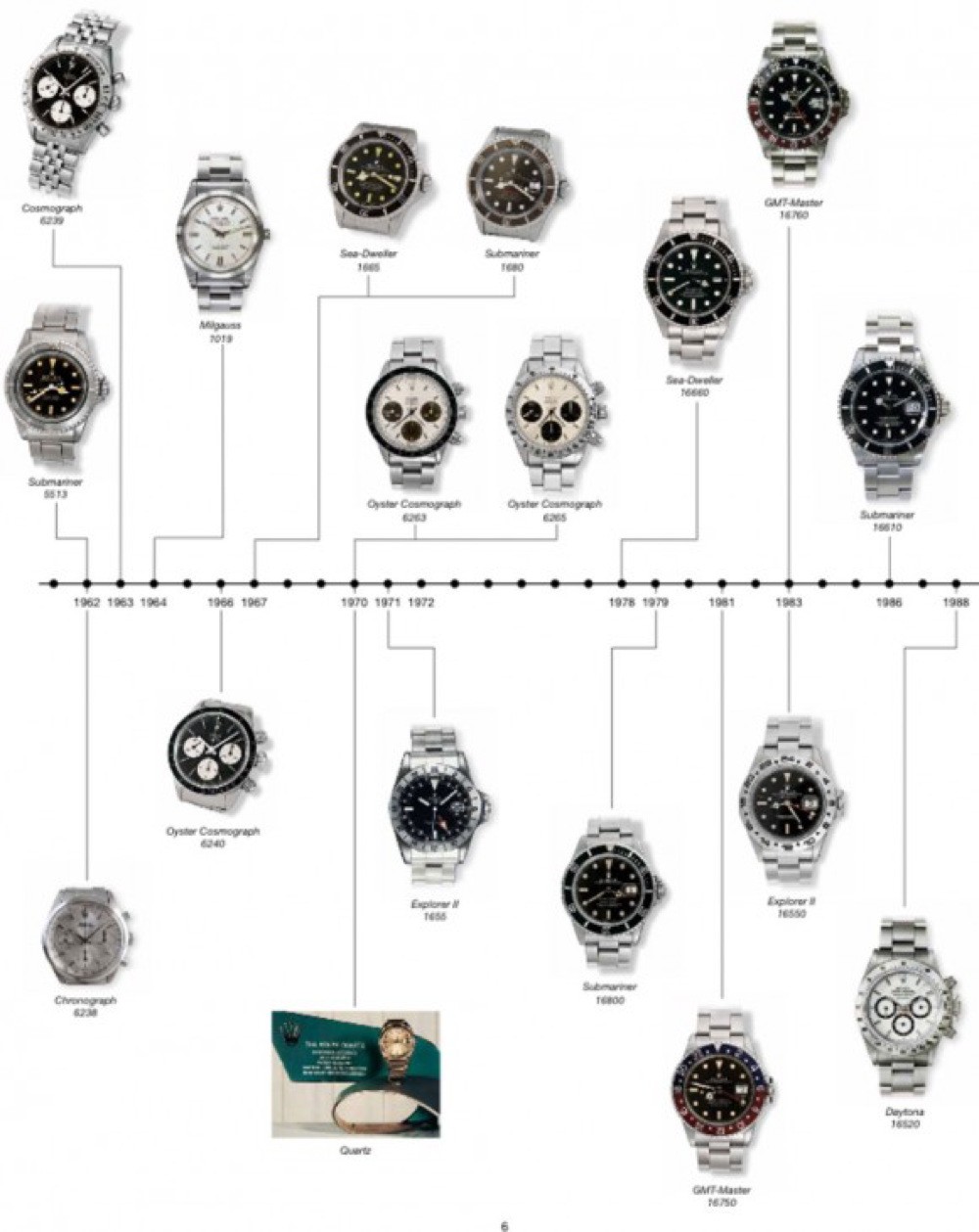 I hope the above quick guidance I set up will help many novice and senior collectors to understand what they are seeing. Always believe your eyes and never the story you get told! Analyze everything up close, use common sense and make your due diligence before you buy a vintage watch or a vintage Rolex in particular! Make sure that when you’re not happy, you can return the watch and never wire any amount if you’re not 100 % sure that this is the actual owner. The world of vintage Rolex is full of scam and laster, relying on a trustable dealer, who has a reputation to defend, is most of the cases the best option you have. In case of any emergency you can always send me a picture to info@RolexPassionReport.com where I will have a closer look at your question and give you my opinion. To determine if a Rolex has the correct serial numbers, where it has been delivered or to get a original Rolex service, you can contact Rolex Heritage Department in Geneva directly. Thanks for reading, I hope you enjoyed it! I wish you lots of fun with your passion of collecting Rolex, or any other watch  Best Regards, Philipp |
|
|

|
|
|
#2 |
|
"TRF" Member
Join Date: Aug 2012
Real Name: Michael
Location: SF Bay Area
Watch: Any Rolex!
Posts: 1,060
|
Excellent post! Thanks for sharing. This should be a sticky in the vintage sub forum.
|
|
|

|
|
|
#3 |
|
"TRF" Member
Join Date: Jan 2011
Real Name: K
Location: KSA
Watch: aholic
Posts: 1,499
|
   is all I can offer at this point is all I can offer at this point 
__________________
"Phlebas the Phoenician, a fortnight dead, / Forgot the cry of gulls, and the deep seas swell / And the profit and loss. / A current under sea / Picked his bones in whispers. / As he rose and fell / He passed the stages of his age and youth / Entering the whirlpool. / Gentile or Jew / O you who turn the wheel and look to windward, / Consider Phlebas, who was once handsome and tall as you." Cheers, K |
|
|

|
|
|
#4 |
|
"TRF" Member
Join Date: Jul 2005
Posts: 22,683
|
Philipp,
I can't express my thanks adquately for this most excellent post regarding vintage. I've moved this to the vintage section and made it a sticky as a reference for all. Thank you. 
|
|
|

|
|
|
#5 |
|
"TRF" Member
Join Date: Apr 2011
Location: Hong Kong
Watch: Gold Sub 116618LN
Posts: 2,820
|
Wow, Philipp...Big thanks. I'm just getting into vintage Rolex here in Hong Kong, and your posts as well as your site & fb page are invaluable. Great work

__________________
Things are more like they are now than they ever were before. |
|
|

|
|
|
#6 |
|
Banned
Join Date: Nov 2010
Location: Kingstown
Posts: 58,279
|
Incredible write up.
  
|
|
|

|
|
|
#7 |
|
"TRF" Member
Join Date: Mar 2009
Location: worldwide ;)
Posts: 390
|
|
|
|

|
|
|
#8 |
|
"TRF" Member
Join Date: Apr 2011
Location: Australia
Posts: 4,689
|
Beautiful writeup Philip, that will go a long way in educating us on the nuances of the vintage watch collecting universe!
__________________
 Last thing I remember, I was Running outta sight I had to find the passage back,To the place I was before. ’Relax,’ said this Rolex place,We are programmed to receive. You can checkout any time you like, But you can never leave! |
|
|

|
|
|
#9 |
|
"TRF" Member
Join Date: Aug 2012
Location: Switzerland
Posts: 14,297
|
Excellent, thank you for sharing!
|
|
|

|
|
|
#10 |
|
"TRF" Member
Join Date: Feb 2014
Real Name: Nicholas
Location: UK
Posts: 2,630
|
Wow, this is fantastic...
__________________
 Nick |
|
|

|
|
|
#11 |
|
"TRF" Member
Join Date: Sep 2009
Real Name: Rich
Location: NC
Watch: Rolex 1675
Posts: 2,359
|
This is so so informative. I learned a ton! Thanks rich
Sent from my iPhone using Tapatalk
__________________
Rich Member of Nylon Nation Red Sox Nation Instagram watchguy97 |
|
|

|
|
|
#12 |
|
"TRF" Member
Join Date: Mar 2008
Location: Amsterdam
Posts: 2,131
|
Brilliant post. Thanks
|
|
|

|
|
|
#13 |
|
"TRF" Member
Join Date: Dec 2010
Real Name: Michael
Location: Brussels
Watch: aholic
Posts: 1,108
|
Absolutely outstanding. This will become my go to reference. Thank you Philipp for taking the time to do this
|
|
|

|
|
|
#14 |
|
2024 Pledge Member
Join Date: Jan 2014
Location: london
Posts: 6,131
|
Now I know what this amazing site is all about. Incredible knowledege fascinating read
|
|
|

|
|
|
#15 |
|
"TRF" Member
Join Date: Mar 2009
Location: worldwide ;)
Posts: 390
|
Thank YOU
 My conclusion: My general believe is that we nowadays see to many 'worked on' vintage watches around. Every day a nice and honest watch somewhere in the world gets a 'treatment' because it's dial is having some little spots or the case has original scratches on it. By changing the original patina you destroy the vintage value for ever. It's like a woman that has got herself a facelift to look more beautiful but doesn't realize it's never possible again to age and to return back to normal. As long she doesn't smile, laughs or cry's, not showing you her emotions, she looks as fresh like a statue or a picture. I strongly believe that even a simple steel Airking or Datejust, a Explorer 1 or even a Cellini will become highly collectable as long it's alive and fresh and all original condition having it's necessary patina all over. The watch market has to understand that exactly these little scratches or small imperfections are the key to future collecting! 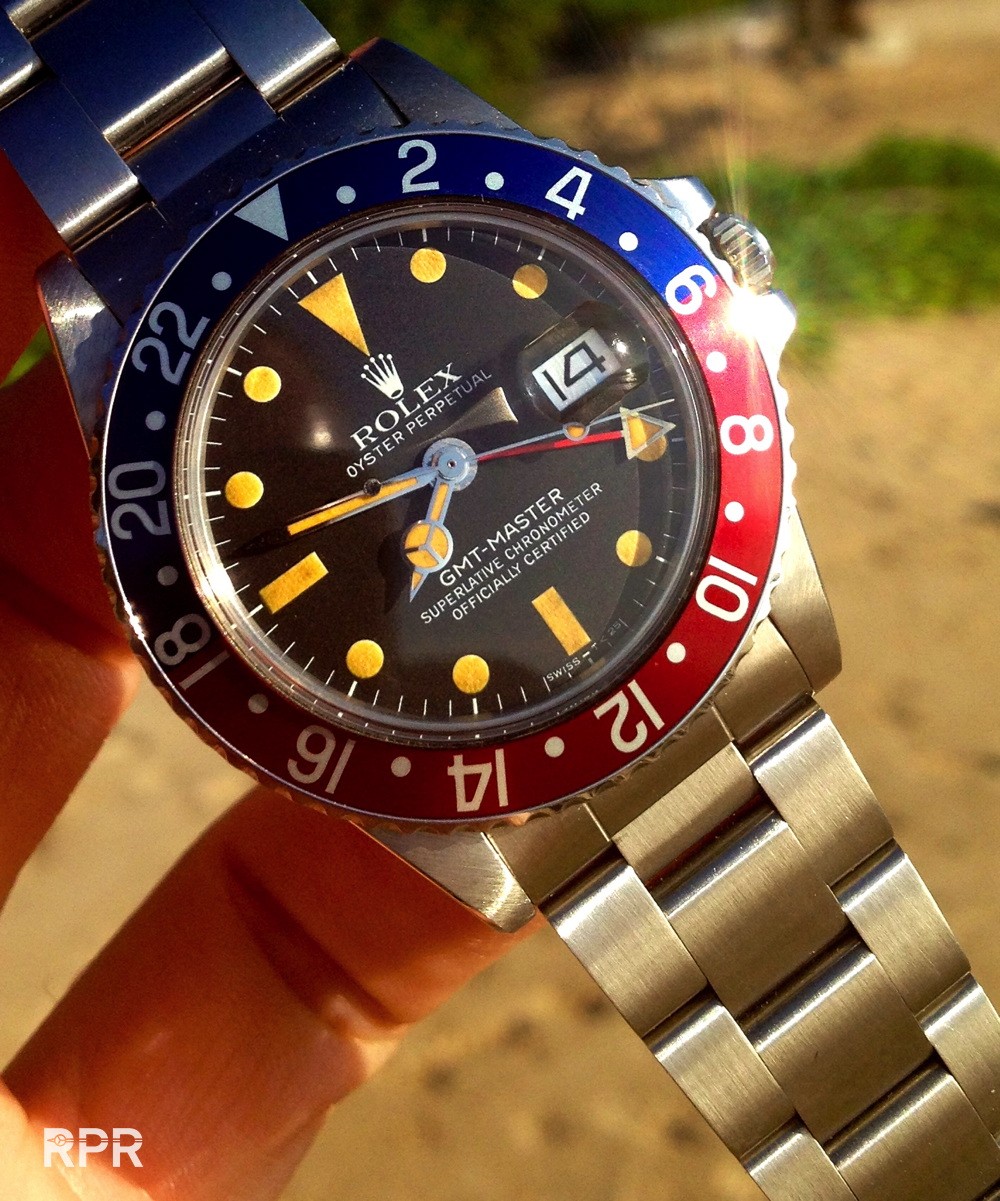 Stop messing around and offer watches like they are and not how you would like to see them. Once everybody understand the importance of originality, we will see that a simple red sub in great condition will be worth double or triple the money they sell now in average. It's due to the experience and knowledge you built up over the years analyzing, comparing and discussing that only honest quality has a future. Not buying a Daytona or even a Paul Newman because 1 lume dot is missing and although the total watch is nice and crisp, is nonsense! What I tried to explain in my guidance is that you have to be aware about a vintage watch that, for instance, got totally relumed by professionals, where the patina is destroyed and thus not worth buying. We have to realize that perfect grail watches are super rare and not everybody will be able to acquire one in crisp "catalogue style" as the price will only go up rapidly because we know now not many more will come to the market. Settle for honest quality is my advise, no matter the reference, believe in true patina!! Regards Philipp |
|
|

|
|
|
#16 |
|
2024 SubLV41 Pledge Member
Join Date: May 2011
Real Name: Larry
Location: San Diego, CA
Watch: ROLEX
Posts: 25,575
|
WOW! Thank You for the information.

__________________
 ✦ 28238 President DD 18K/YG ✦ 16610LN SS Sub ✦ 16613 18K/SS Serti ✦ 16550 Exp II Non-Rail Cream Dial ✦ Daytona C 116500 ✦ 126710 BLRO GMT-Master II ✦ NEXT-->? ⛳ Hole In One! 10/3/19 DMCC 5th hole, par 3, 168 yards w/ 4-Iron.  |
|
|

|
|
|
#17 |
|
2024 Pledge Member
Join Date: Nov 2005
Location: Member 202♛
Posts: 1,814
|
Thank You! and Where's Part I
Phillip,
You outdone yourself once again. Thank you for posting. Where can we find Part I. (oops found it... my bad... I should have looked :bang head:) Also, you going to be at IWJG in Las Vegas Monday-Tuesday. Would like to see you. Best, Sheldon
__________________

|
|
|

|
|
|
#18 |
|
"TRF" Member
Join Date: Jul 2010
Real Name: tom
Location: northern ireland
Watch: my fins
Posts: 10,063
|
one of the best posts ive ever read ,,, glad its to be a sticky.
|
|
|

|
|
|
#19 |
|
"TRF" Member
Join Date: Nov 2008
Location: USA
Posts: 2,615
|
Great write up Philipp. Thanks for taking the time.
__________________

|
|
|

|
|
|
#20 |
|
"TRF" Member
Join Date: Jul 2012
Real Name: George
Location: Sydney
Watch: 5513
Posts: 1,104
|
Highly informative Phillipp, thank you
|
|
|

|
|
|
#21 | |
|
"TRF" Member
Join Date: Mar 2009
Location: worldwide ;)
Posts: 390
|
Quote:
Hi Sheldon, I hope all is fine with you! Sorry, I won't be in Las Vegas but you can reach me on info@rolexpassionreport.com if you have any questions. & Thanks to all of you, greast seeing you all like the guidance so much!  I just updated with the by me forgotten " Provenance " :bang head:  Provenance: I like to add in a update the proven history of a watch. Wikipedia says about provenance: The chronology of the ownership, custody or location of a historical object. the primary purpose of tracing the provenance of an object or entity is normally to provide contextual and circumstantial evidence for it’s original production or discovery, by establishing, as far as practicable, it’s later history, especially the sequences of it’s formal ownership, custody and places of storage. The practice has a particular value in helping authenticate objects but establishing provenance is essentially a matter of documentation. With a Rolex this could ve the original Rolex warranty papers that state the reference number and in some cases the serial number, the COSC chronometer certificate that state the serial number and movement number, the original receipt stating the price and article description, later service papers confirming the serial and reference numbers. Having pictures from the past showing the owner while wearing it and a letter stating it’s history is a must. As Rolex has delivered many different markets in the world, sometimes using local suppliers like we see with bracelets a lot for instance, many different versions of the same reference have come to the market. Having a proper provenance can provide us prove about the originality how it has been delivered initially. When you buy a vintage Rolex from first owner or from the relatives, always ask for extra information they can add. The more provenance you have, the better it is! 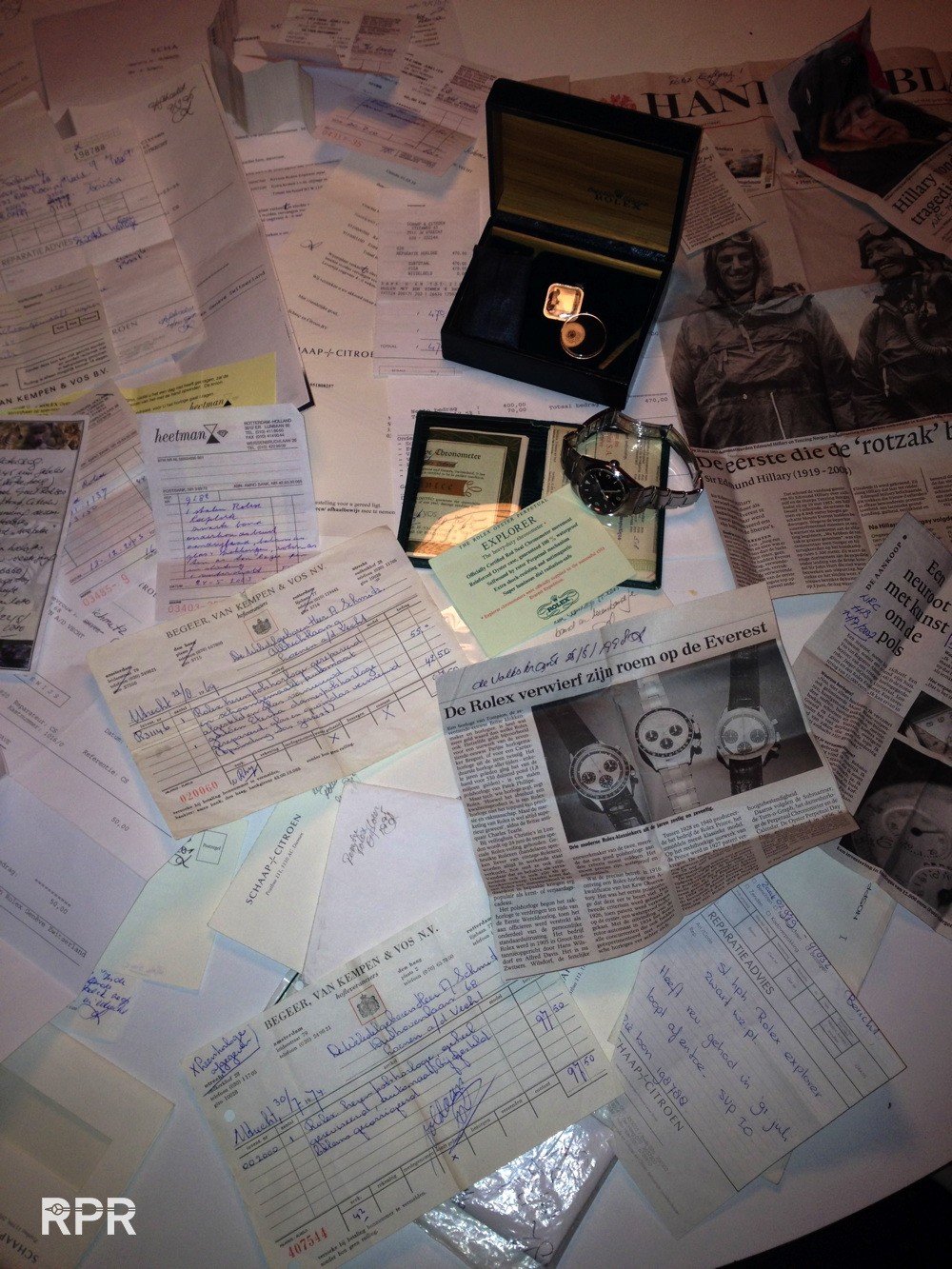 The complete guidance is on: http://rolexpassionreport.com/14962/...vintage-rolex/ |
|
|
|

|
|
|
#22 |
|
"TRF" Member
Join Date: Dec 2008
Location: PA
Watch: SubLV, 1665 Rail
Posts: 1,054
|
What a thoughtful and informative post! Thanks for taking the time to write it up

__________________

|
|
|

|
|
|
#23 |
|
"TRF" Member
Join Date: Mar 2013
Real Name: peb
Location: Istanbul
Posts: 3,145
|
Great post and a guide! Thanks

|
|
|

|
|
|
#24 |
|
Member
Join Date: Oct 2013
Location: nova scotia
Watch: the shiny one
Posts: 18
|
The R in Rolex font. Are there any cases where the original dial displays the R not elongated ? or is that an automatic giveaway the dial has been refinished ?
|
|
|

|
|
|
#25 |
|
"TRF" Member
Join Date: Mar 2009
Location: worldwide ;)
Posts: 390
|
grmike The R in Rolex font. Are there any cases where the original dial displays the R not elongated ? or is that an automatic giveaway the dial has been refinished ?
Every Rolex reference has it’s own unique Rolex crown, printed or applied on their dial. To make it even more complicated, in those references that had been produced for a long time ( Like 5512, 5513, 1675, 1016 etc) we see different types in different periods. In the near future I’ll make a overview, for now a collage: 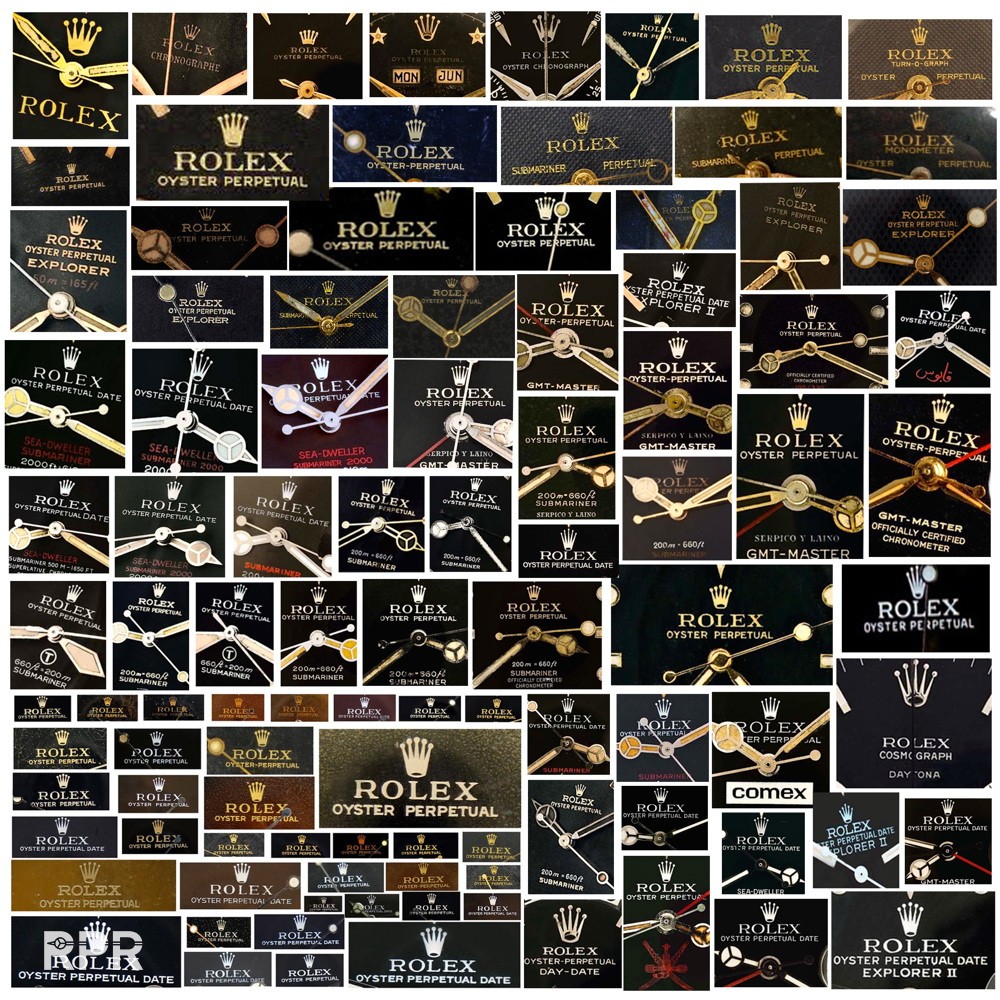 
|
|
|

|
|
|
#26 |
|
"TRF" Member
Join Date: Mar 2008
Location: Amsterdam
Posts: 2,131
|
That, my friend, is a seriously COOL pic
|
|
|

|
|
|
#27 |
|
"TRF" Member
Join Date: Aug 2014
Location: Baltimore, Md
Posts: 1
|
Absolutely Amazing! I am new to collecting and this is hands down the most informative and helpful education I have received since I've started. Thank You!!!
|
|
|

|
|
|
#28 |
|
"TRF" Member
Join Date: Feb 2013
Location: Idaho
Posts: 34
|
Top shelf post and thank you
|
|
|

|
|
|
#29 |
|
Banned
Join Date: Jan 2014
Location: US
Posts: 101
|
great article. It would be nice to feature some side by side comparisons of unpolished vs polished cases. Overly polished cases are pretty obvious, but many new collectors could use guidance on what constitutes a thick case, original beveled edges vs redone one during a restoration.
|
|
|

|
|
|
#30 |
|
"TRF" Member
Join Date: Mar 2009
Location: worldwide ;)
Posts: 390
|
Read & study also my recent articles on www.RolexPassionReport.com
Be Aware of High Quality Vintage Rolex Dials: --> http://rolexpassionreport.com/15348/...e-rolex-dials/ 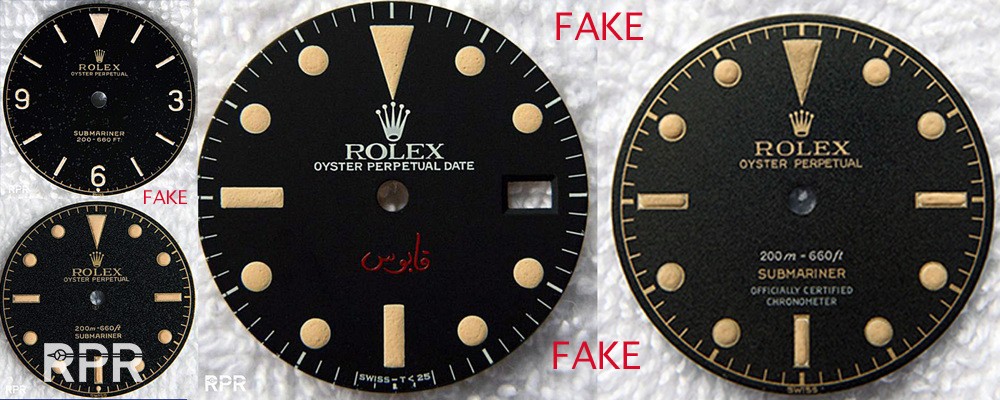  What do you need to know, the 10 golden rules to determine a vintage Rolex!
|
|
|

|
 |
| Currently Active Users Viewing This Thread: 1 (0 members and 1 guests) | |
|
|
*Banners
Of The Month*
This space is provided to horological resources.